Egypt
When I planned my route to Egypt I wasn’t really sure if I would be able to cross over at the Sinai peninsula to get to mainland Africa. Some people said it was doable, some said it was impossible, but I took the risk anyway and succeeded. For many years Sinai has been a no go for tourists with vehicles due to terrorist attacks in the past. These days there are two ways of crossing to Sinai. One is via land from Israel in Taba. The other on the ferry across the Red Sea from Aqaba in Jordan to Nuweiba in Egypt. I didn’t even want to have a go at crossing in Taba after hearing so many stories of overlanders who didn’t succeed. Crossing that border (coming from the North) is like winning the lottery – it can happen but it’s very unlikely. But there is another thing you need to consider when you decide to cross in Taba. Although Israel doesn’t stamp your passport, Egypt does and having a stamp from Taba clearly means you have been to Israel and that can cause you troubles at the Sudanese border as they are not too friendly with each other and Sudan can reject your entry in the worst-case scenario. Frustrating stuff this politics I know, but you have to be aware of it.
So the ferry from Jordan is the most non-problematic way of crossing into Sinai and it’s the only ferry that allows you to get off with your bike onto Egyptian soil. There are cargo ships from Europe to Alexandria but they are only roll-on/roll-off which means you can only send your bike and you have to catch a flight to pick it up. So the route I took may not be the fastest way to get to Africa but it allowed me to cross from one continent to another without separating from my bike.
The Hardest Border Crossing In The World
The ferry from Aqaba to Nuweiba only took 3 hours so there was not really much time to have any rest. We arrived at the port at 3am and it’s really hard for me to explain what exactly happened during the next 10 hours at the Egyptian border. Ok, I’ll give it a shot and try to explain the best I can.
For the first time ever I decided to use a “fixer” at the border. A Fixer is a local guy who is supposed to help you with all the paperwork and any dealings with border authorities. The fixer who was recommended by a friend got sick so he sent his friend who didn’t speak English. That was the worst decision I’ve made, it’s pointless to have someone who’s doing all the procedures on your behalf and he can’t communicate with you and you have no idea what’s going on. Even more frustrating was that all the immigration officers got upset with my fixer, not sure why because I couldn’t understand a thing. But when all of them started yelling at each other it was time to ask the fixer to stop representing me.
So a tourist police officer took my case and looked after me through the whole procedure. His English was basic so my lifesaver Maya from Jordan was on the phone with him as a translator for most of the time.
The biggest problem I faced was that the customs officer didn’t like the format of my Australian carnet. Even now I don’t know why but it’s a common problem on this border with Aussie carnets. The only explanation I got from them was that “The format is too new”, whatever that means. I was told I need to leave my bike at the port and catch a 13hour bus to Cairo to pick up a piece of paper from the Automobile Club and come back to complete the customs procedure. Insane, right?! But luckily Maya managed to convince the customs officer to accept a copy of that paper sent via fax. My other lifesaver and future host to be, Yara from Cairo managed to organise this piece of paper from the Automobile Club within an hour and had it faxed to the officer at the port. Thanks to the help from these two girls I saved 3 days of mucking around.
For the remainder of the 10 hours, I was running from one officer to another paying all these fees I’d never heard of. And in between whilst waiting I had a snooze cause I just couldn’t keep my eyes open. That was one of the most exhausting days of my life.
Ok, here’s the rundown of all the fees and costs I had to pay:
-
US$25 Visa
-
EGP£130 (US$7) Insurance
-
EGP£320 (US$19) Traffic Fee (new rego)
-
EGP£310 (US$19) Port Tax
-
EGP£520 (US$31) Carnet
-
US$90 for the piece of paper from the Automobile Club in Cairo
-
20 Euro for the fixer who didn’t really help much I had to give him something for his time
-
20 Euro tip for the Tourist Officer, it’s not necessary I guess but it’s expected
Although 10 hours seemed to be a long time to spend at the border, the fact is this was the best-case scenario. Some of the travellers I know had to leave their bikes for 3 to 14 days at the border before they got all their paperwork right. So I was just so happy I could complete all of this nonsense within a day thanks to a little help from my friends.

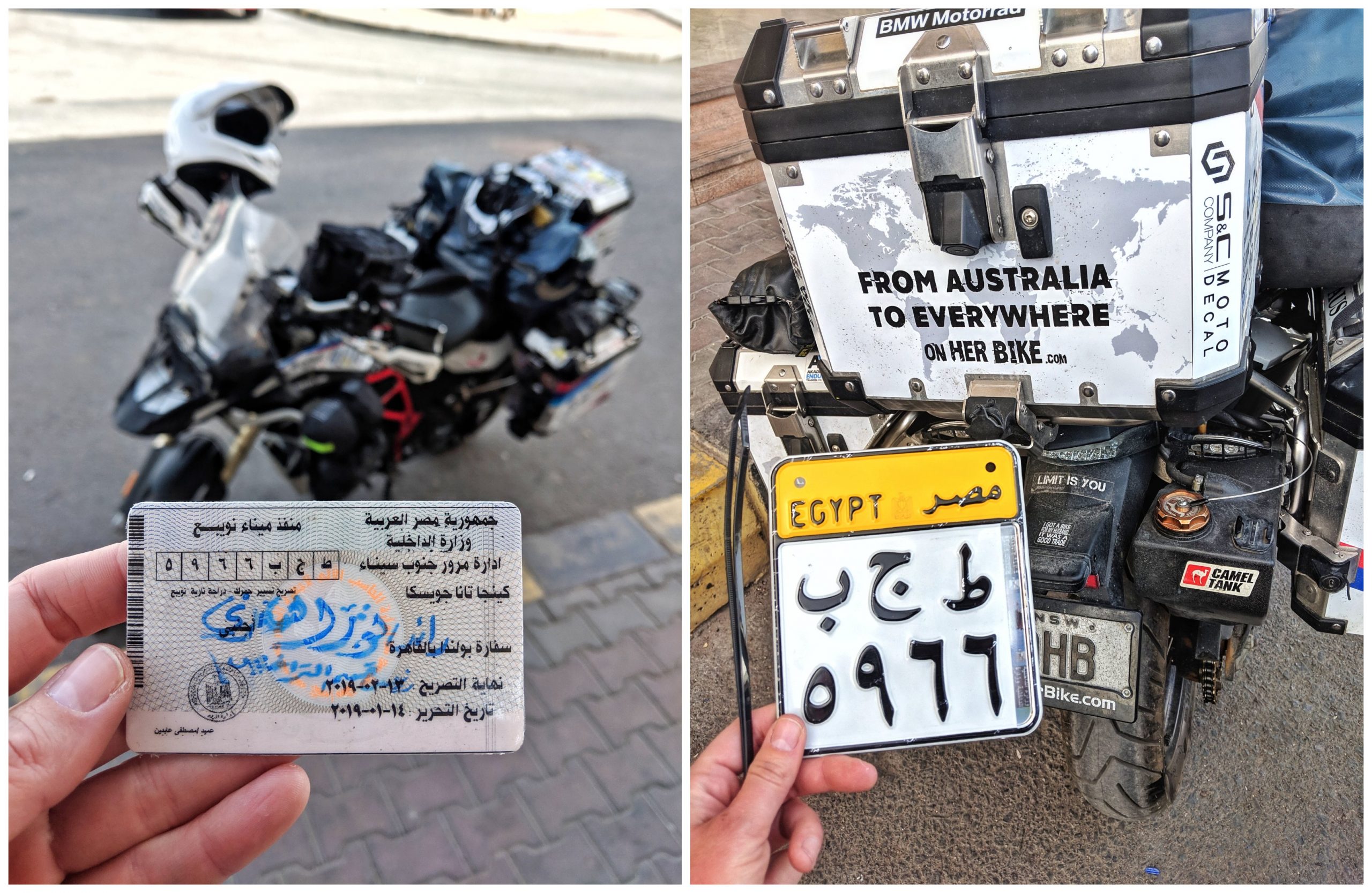

 Crossing Sinai
Crossing Sinai
I was so relieved when I finally exited the gate from the port. I stopped my bike to take the first picture in Egypt. I made it!
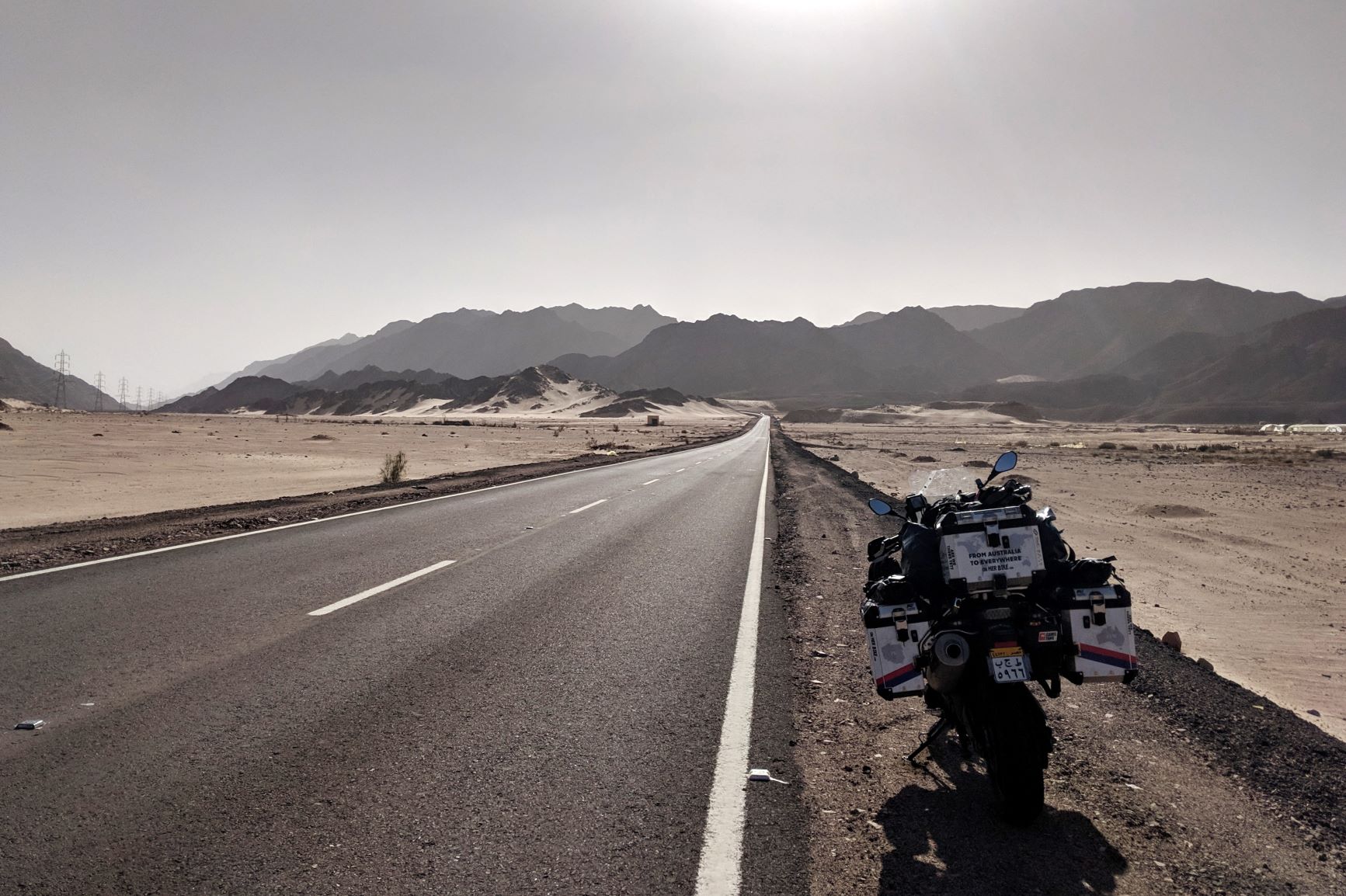
But I couldn’t relax completely just yet. There was another issue to face. Crossing Sinai required a few extra logistics and a bit of truth-stretching. I followed the instructions from an Egyptian rider Omar from Alexandria and didn’t have any big issues with getting to the mainland. The only road that is allowed to be travelled is the coastal road where approx every 50km you pass through police checks where they check your papers and possibly give you an escort. This whole process of checkpoints may not be needed these days as many more overlanders are coming into Egypt via this route but I didn’t take any chances. So here’s the procedure for how to cross from Sinai into the mainland via the Suez Canal. On arrival to the Nuweiba port, I told officers I was only going to Dahab to do a diving course and then I was coming back to catch the ferry to Jordan. When I exited Dahab I told the policemen I was only going to Sharm El Sheikh to stay in the resort and I’d be back in a week. On my exit of Sharm El Sheikh, I told them I was going to Cairo. And once they let you out of Sharm El Sheikh you’re in business! You don’t have to lie anymore. There is 380 km from Sharm El Sheikh to the Suez Canal and it’s gotta be done within a day, the police won’t let you stay overnight along the way, they just want you out of there ASAP. From Sharm to Cairo is about 500km and I wanted to get it done in one day so I left very early and it took me 10 hours. For the last 300km before I reached the Suez Canal I was escorted by the police. So the way it works is every 50 km a police vehicle hands me over from one checkpoint to another. Sometimes they were going ahead of me, sometimes behind me… and in one case, I was nearly losing them cause they were only going 70km/h. But not to worry, they were all very nice about it and I knew even if I lost one there’d be another one waiting for me in a few kilometres. I’m not sure if this procedure applies to all travellers, I know riders in groups weren’t escorted for such long periods of time.
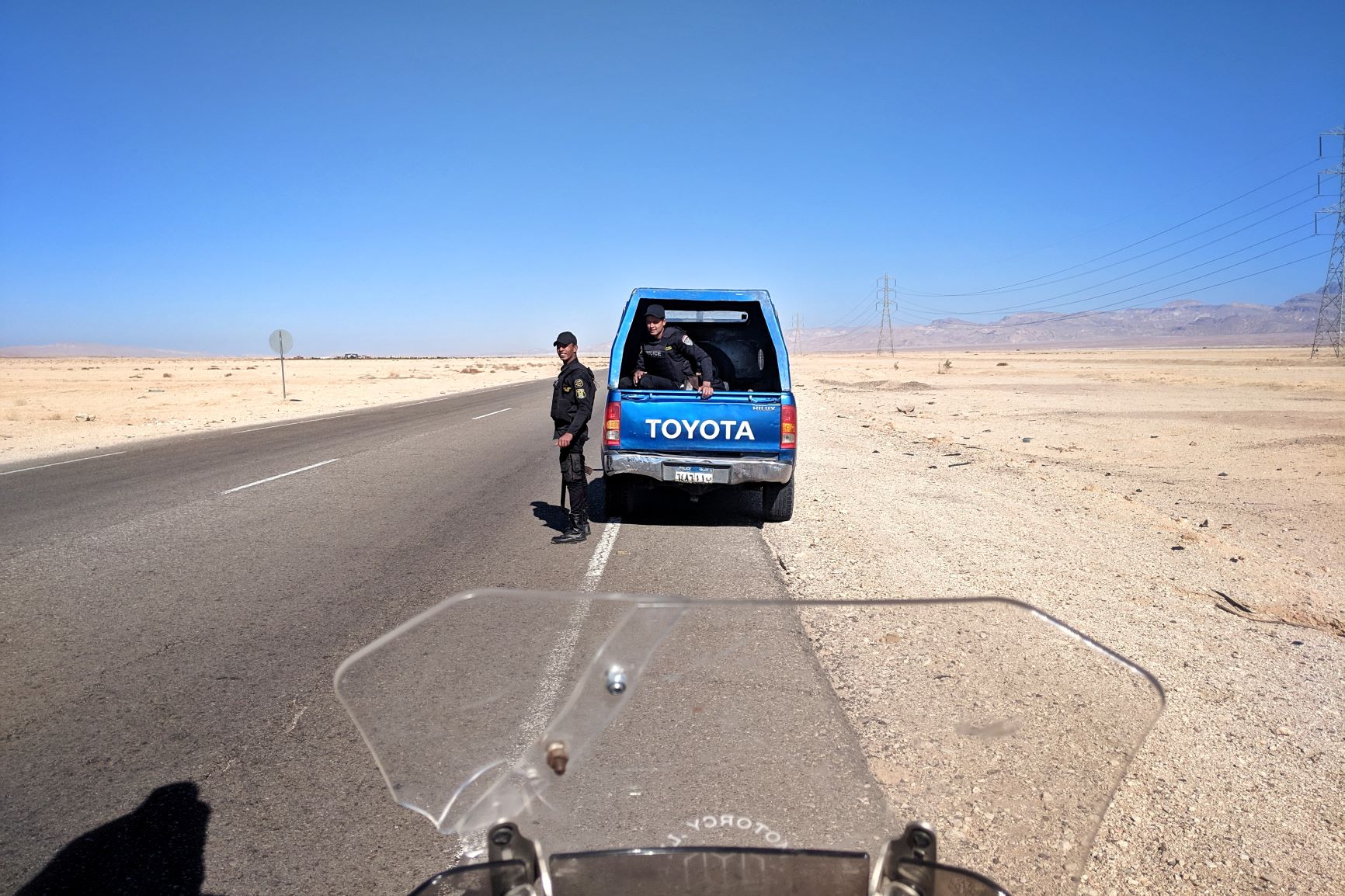


Holidays in Sinai
After arrival on the ferry, there was Dahab – one of the best places to chill in Egypt! Dahab is a former fisherman’s village which is these days a cool little town with great vibes and one of the best spots in the world for windsurfing, scuba diving and kite surfing. There are no 5-star resorts but lots of budget hotels and apartments. Everyone is super relaxed there and there is no other place in Egypt like Dahab.



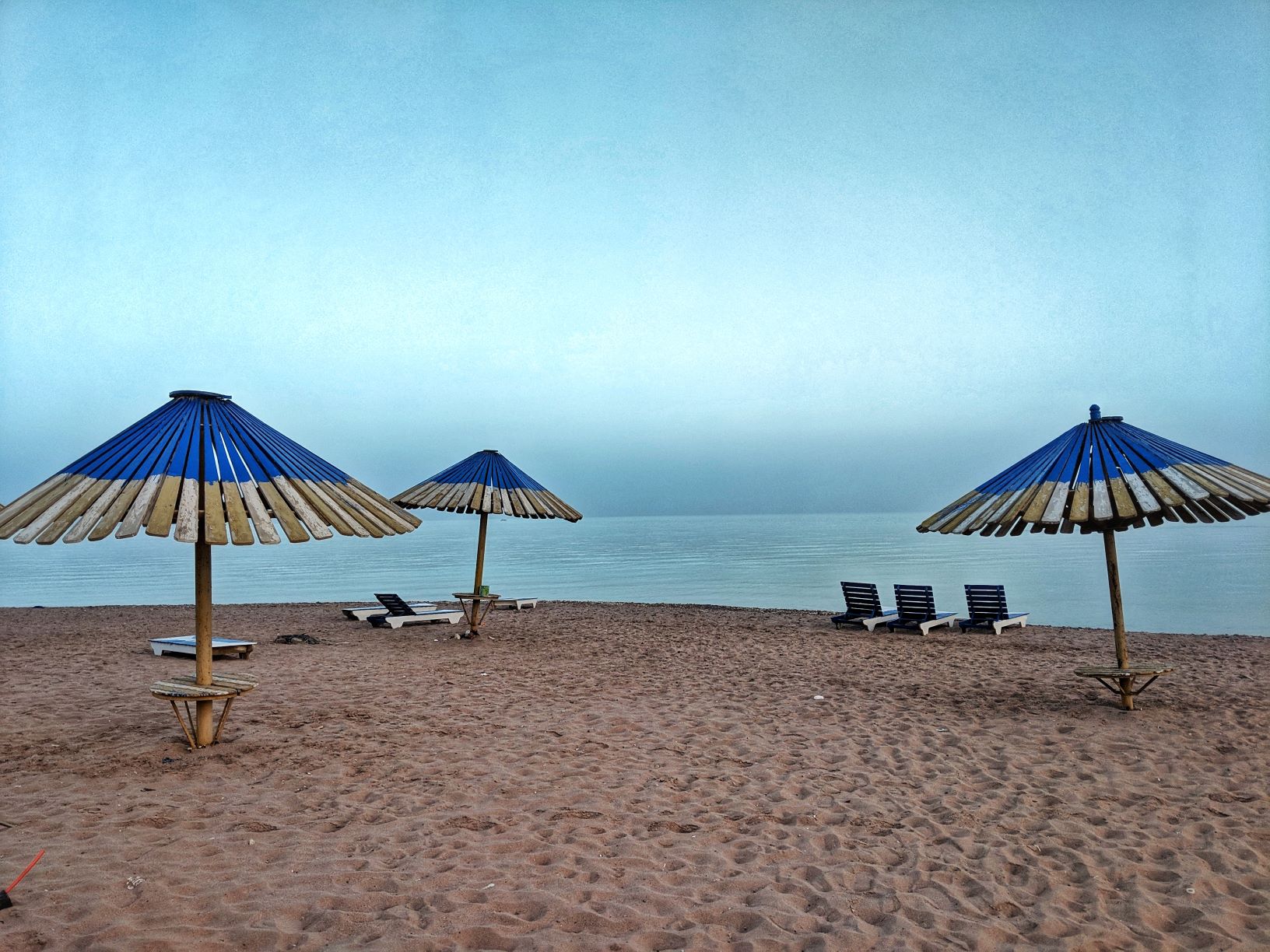
Due to past history with terror attacks, not as many tourists visit Sinai’s accommodation and the local attractions have become cheap. I paid 13 Euros for this place! Bargain, I’m in!

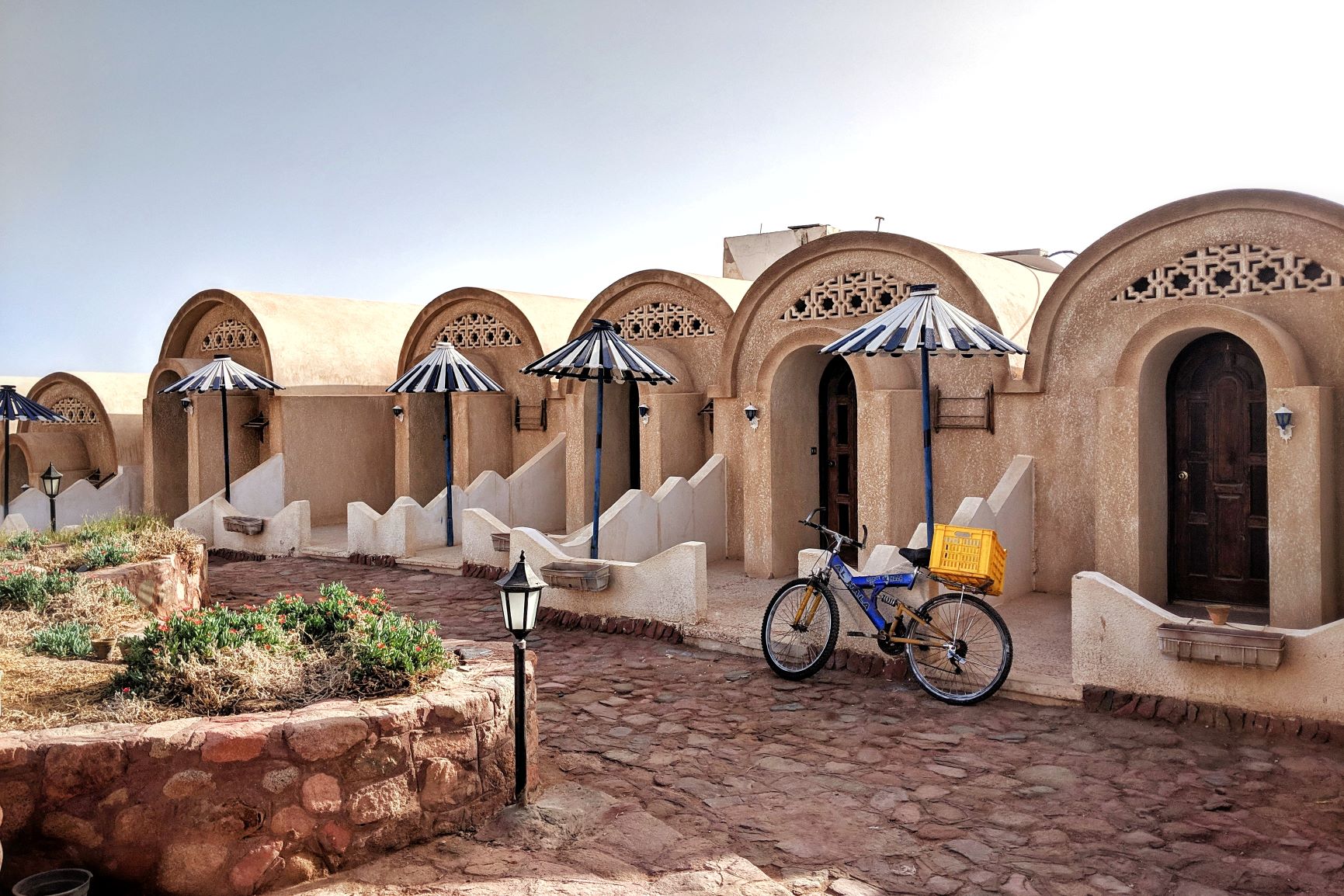


I spent a week here just chilling, catching up on some social media work and hanging with this great bunch of riders, that I just got on with like a house on fire. The riding community is the best no matter where I go.
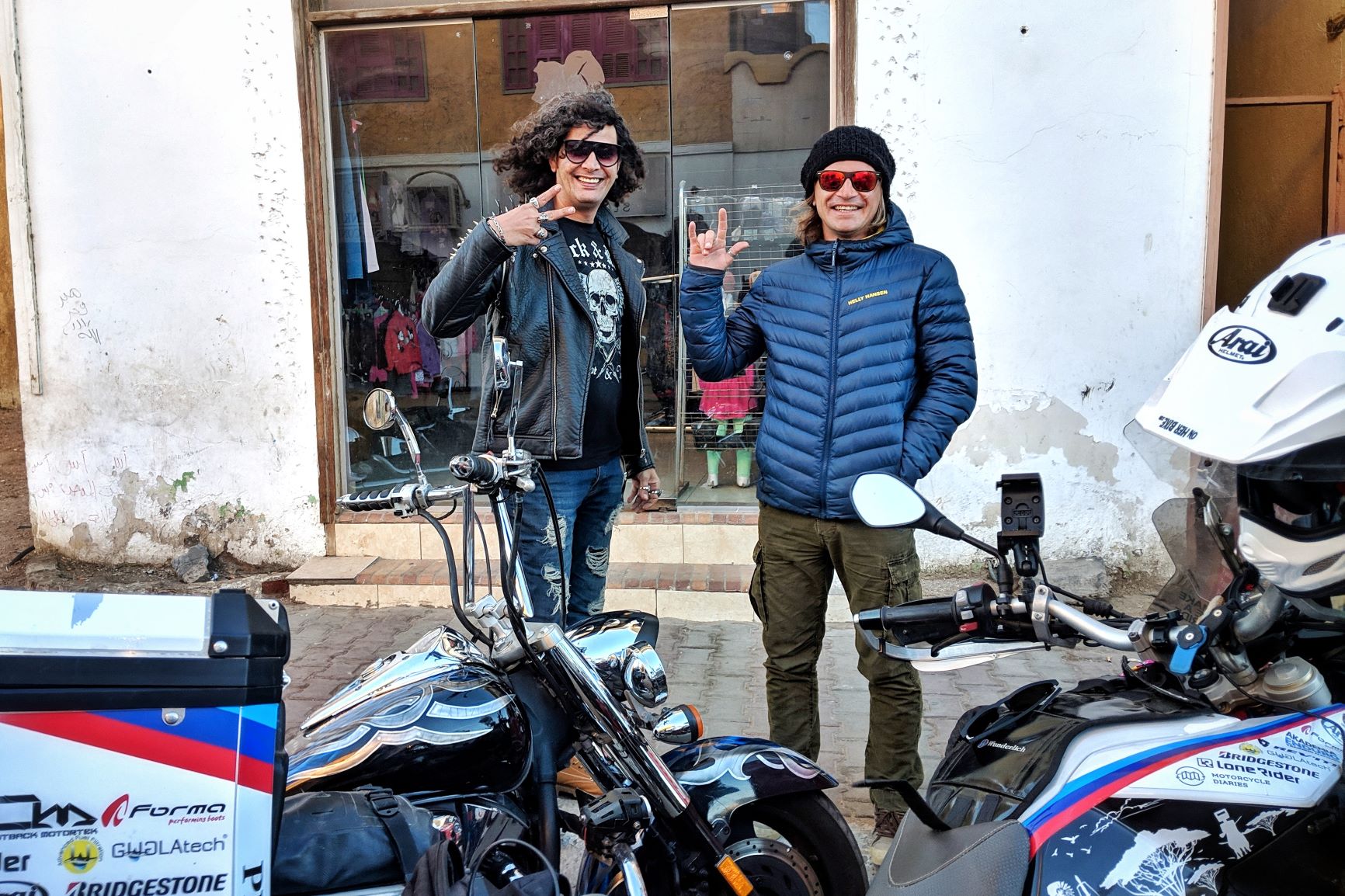
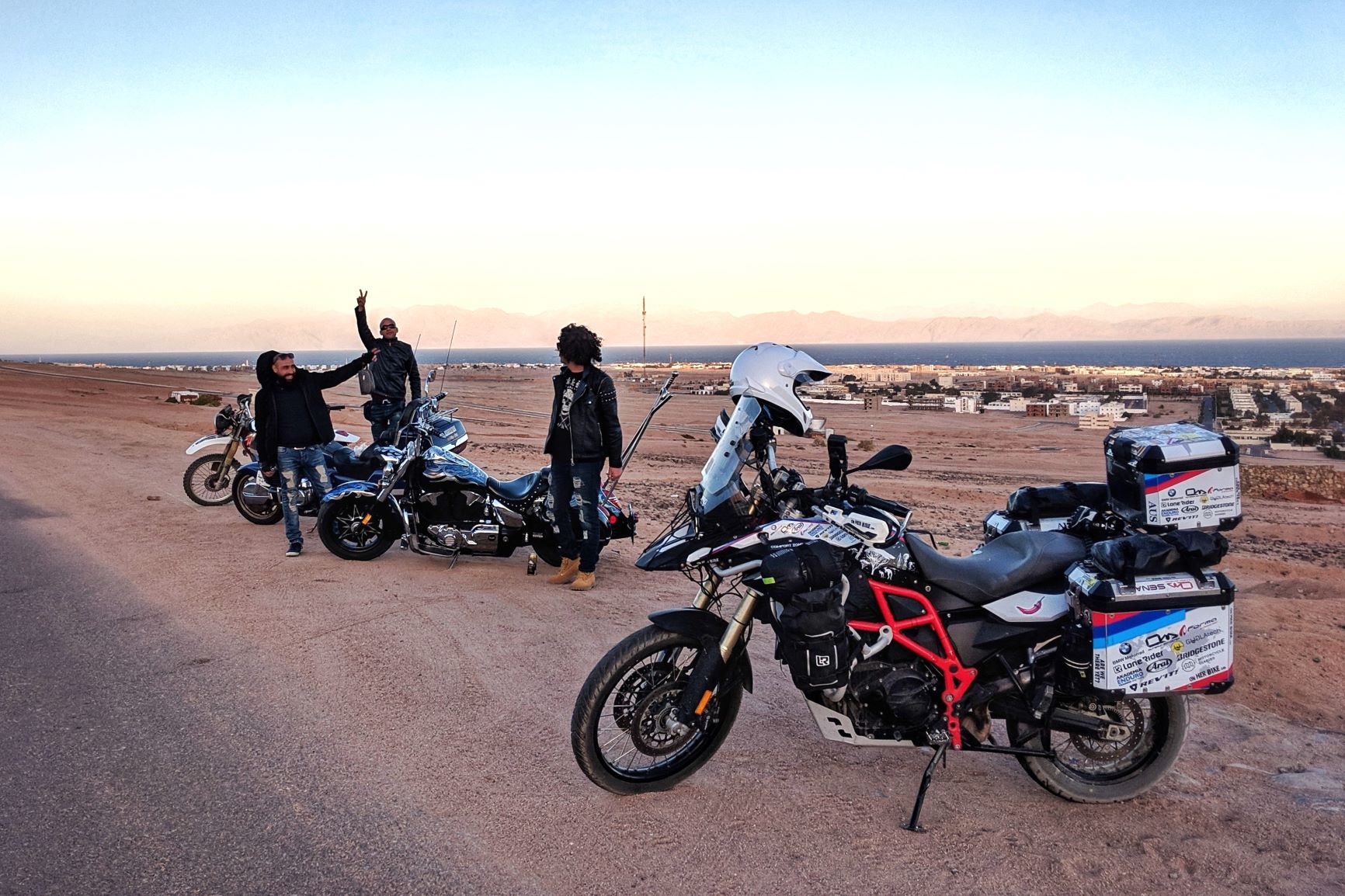
Here I also met Maxi – a talented artist who painted my helmet. This is the outcome of our collaboration. My Arai XD5 is so badass now, isn’t it?!
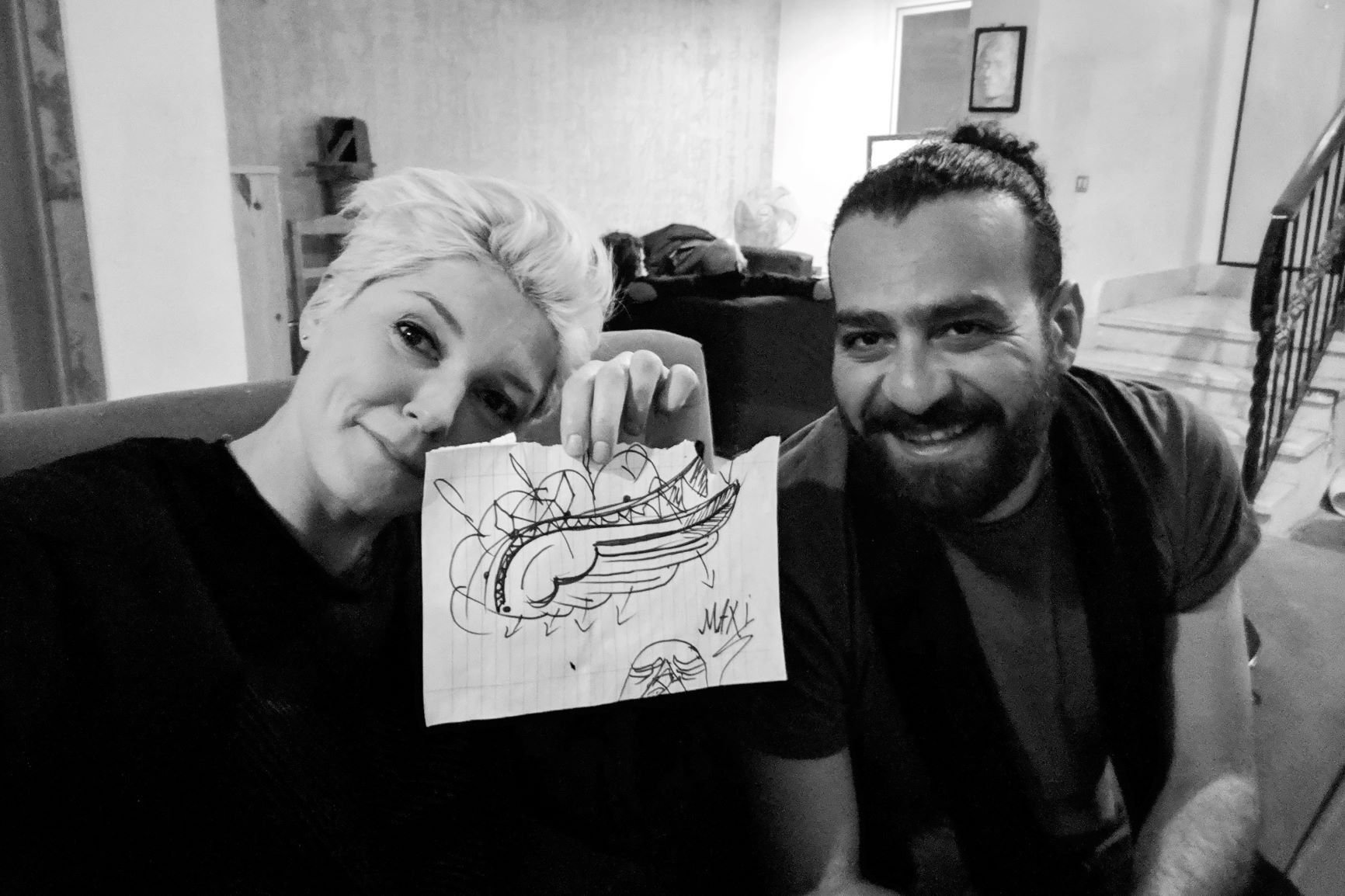
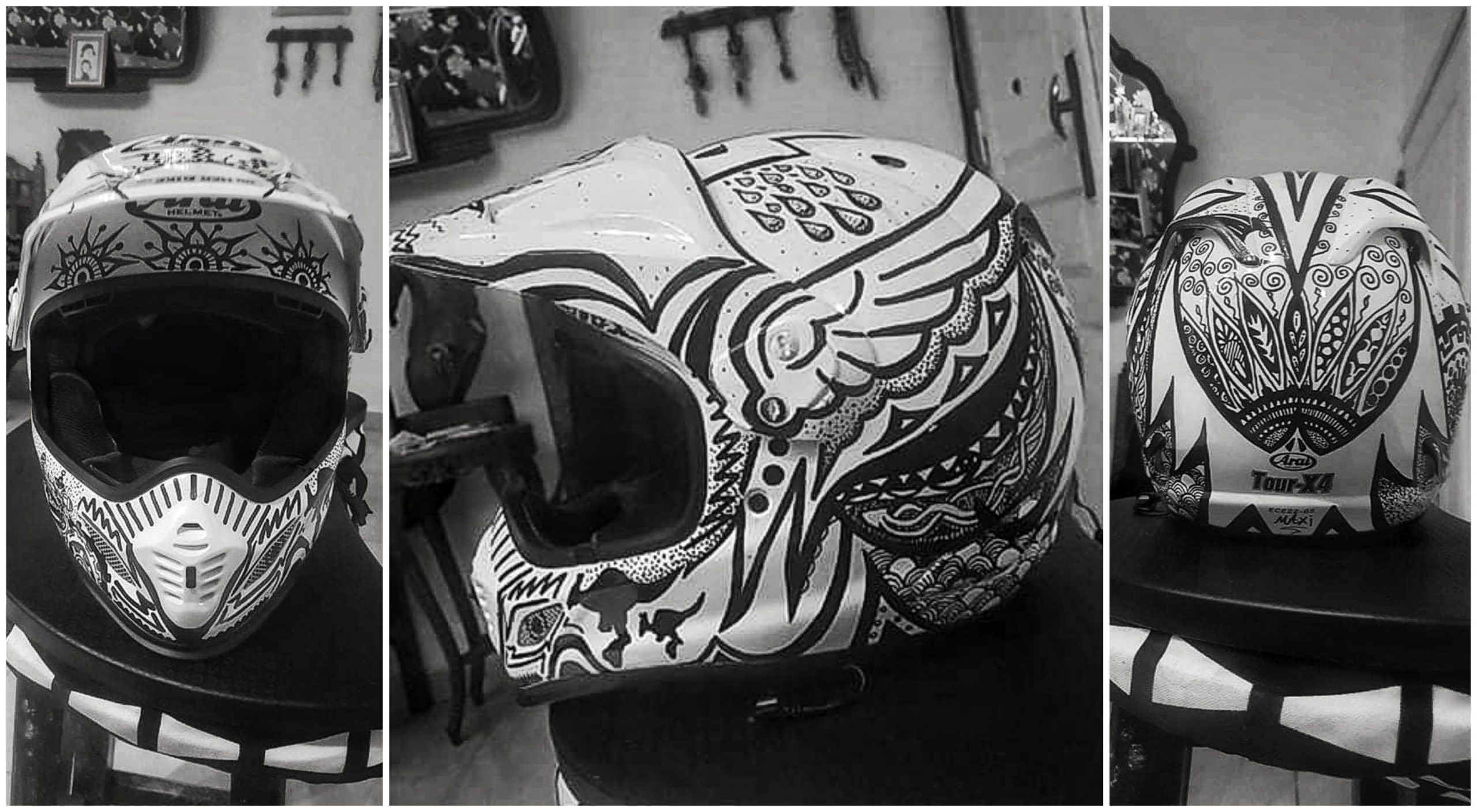
Resort type holidays are not normally my thing, but after such a long time on the road, I really appreciated this bit of luxury and the time to chill with my mum. She had flown in to spend some time with me in Sharm El Sheikh. Sinai offers one of the best spots for diving so we couldn’t miss out on this opportunity! We dived, explored the desert on quad bikes, rode camels on the beach and drank cocktails – many, many cocktails by the pool! Such great memories.






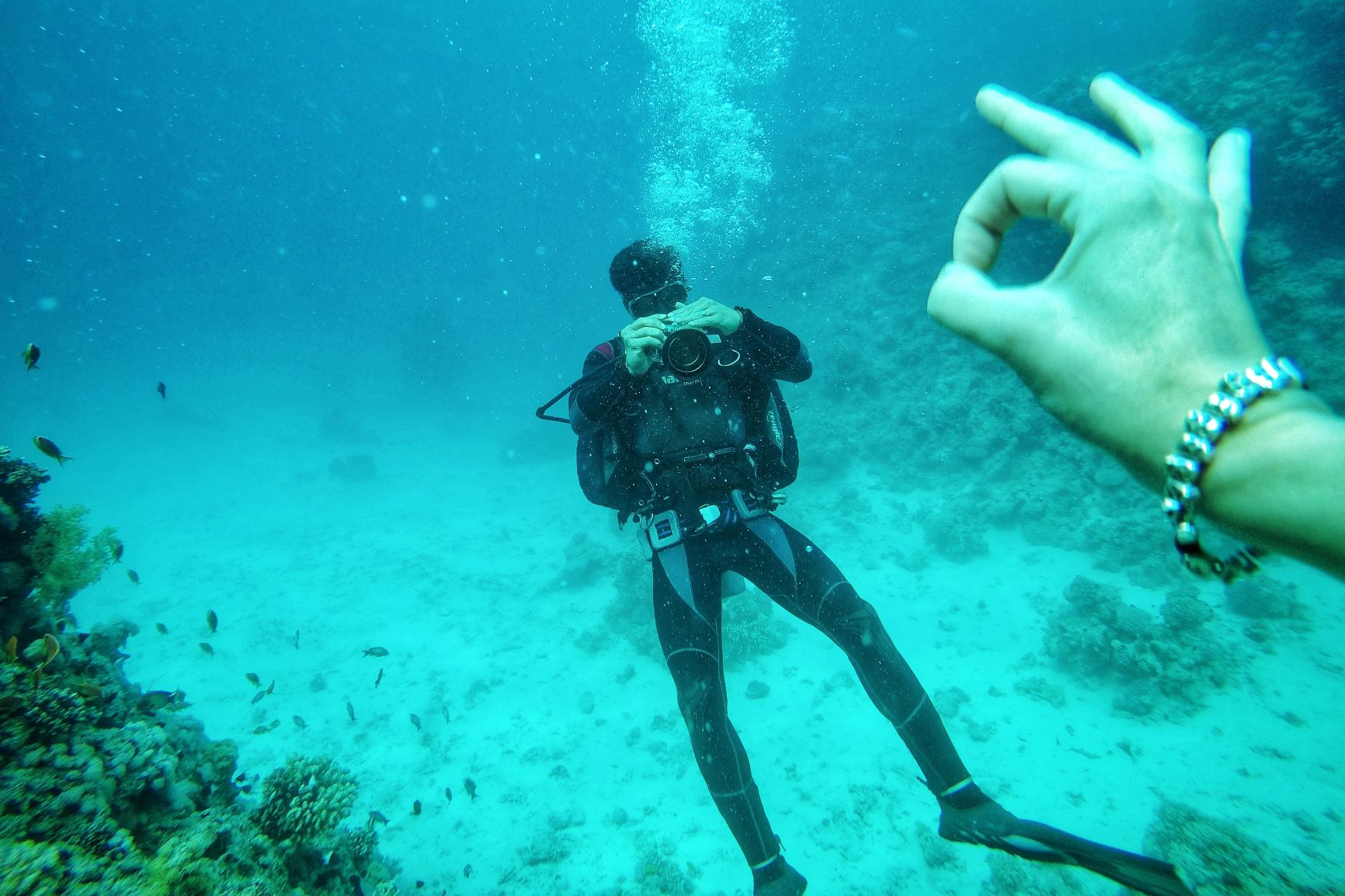

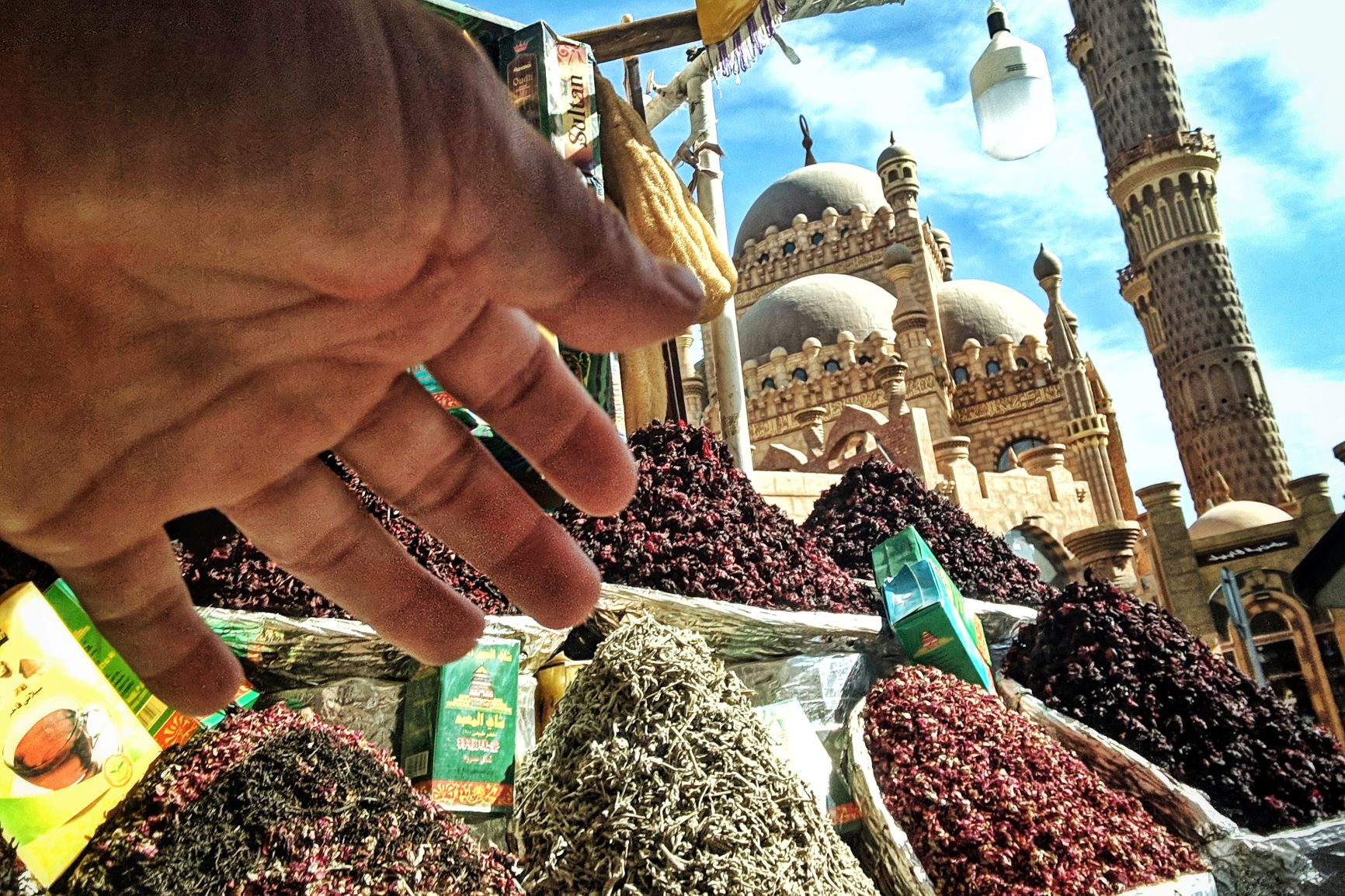
Cairo
If I had to do a list of the most dangerous cities to ride a motorcycle in, Cairo would have to be in first place by a long way. The traffic is absolutely insane everyone who shares the road is aggressive and fast. You have to stay sharp and alert at all times and fight for the bit of the road you’re on. Riding around Cairo really saps all your energy so I limited it to a minimum, but the Pyramids were a must!

I had always imagined that the famous pyramids of Giza would be in the desert, but it turns out they’re in the heart of Cairo. My mate Julie who had visited me from Australia joined me for this adventure ride. Don’t know how she stayed sane on the back of the bike in such intense traffic! But we made it there safe and sound, phew. Unfortunately, motorcycles are no longer allowed at the pyramids so we had to leave Chillie in the parking lot. It would take a couple of hours to take in the pyramids on foot, which at the time was a no-no for me with my still healing leg. So we hired a guide and an “Egyptian Cadillac” as he called it (a horse and carriage).



As for the pyramids I had to confess that I had thought they were a little bit… bigger. No disappointments though, they’re still impressive and it’s mind-blowing, thinking about how they were able to build them 5000 years ago!




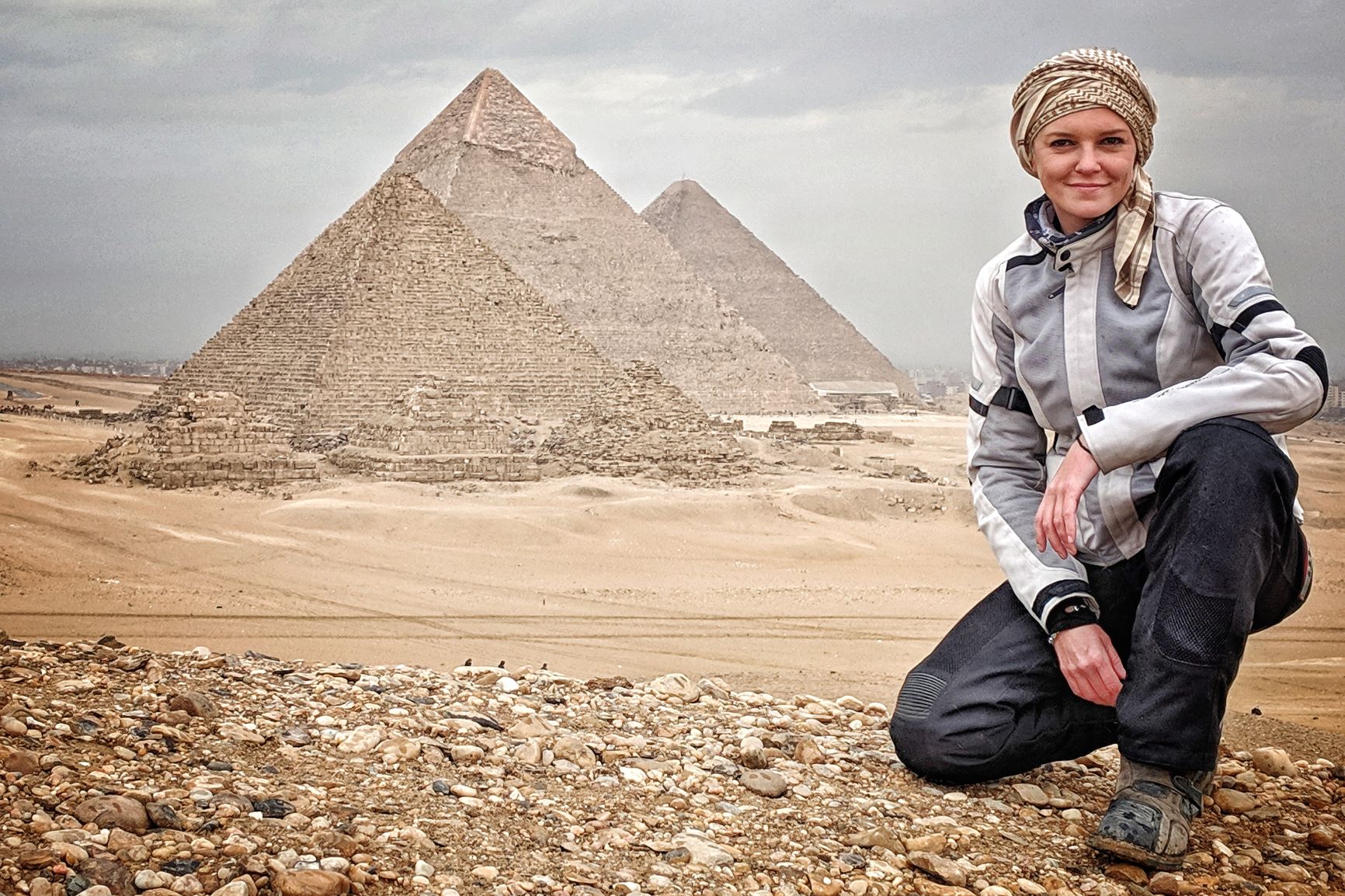


Throughout my whole stay in Cario, I was hosted by Yara whom I was introduced to through mutual friends. She helped me big time with faxing the paperwork to the border and now I finally got to meet her.
Yara is an absolute legend. She’s the only female rally racer in Egypt and one of very few in the Middle East. She won several local rallies in Egypt and has been awarded National Champion in 2014, 2016 and 2017. She’s also been internationally competing and winning many rallies in the UAE, QATAR, Jordan, and was the first women ever to compete and race in Saudi Arabia.
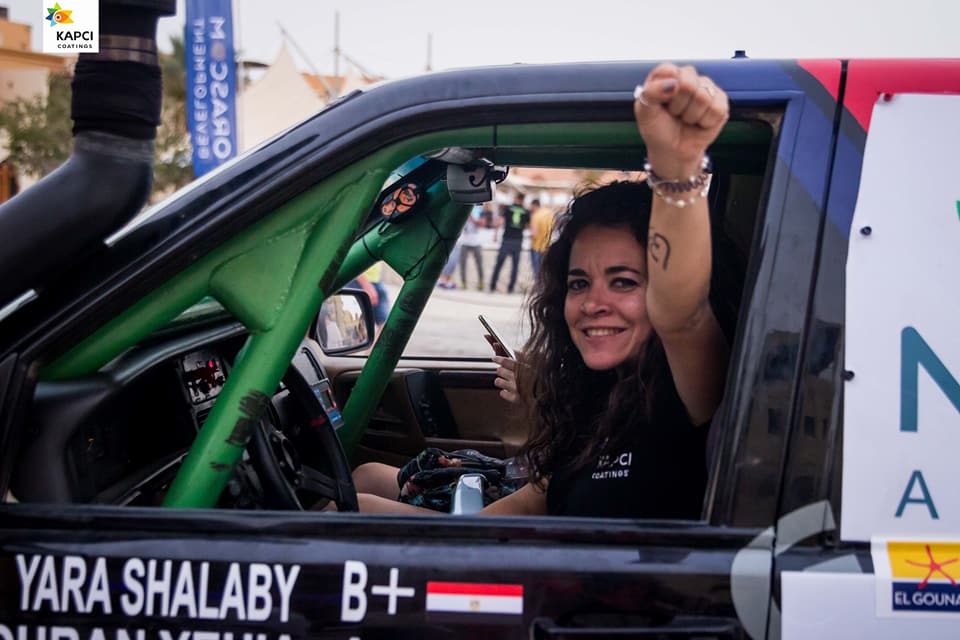
Yara made me feel at home. We had the best time hanging out during my stay there and become great friends. Her hospitality was wonderful and her help indispensable.
The White Desert
Julie and I joined Yara and a group of her friends for an off-road weekend in the White Desert which is about 500km away from Cairo. We arrived there late at night, set up tents half asleep but in the morning I realised how incredible this place was!
The White desert is very unique, it’s colours and composition aren’t found anywhere else. These white stones look like ice. It’s hard to imagine it’s still on planet Earth.


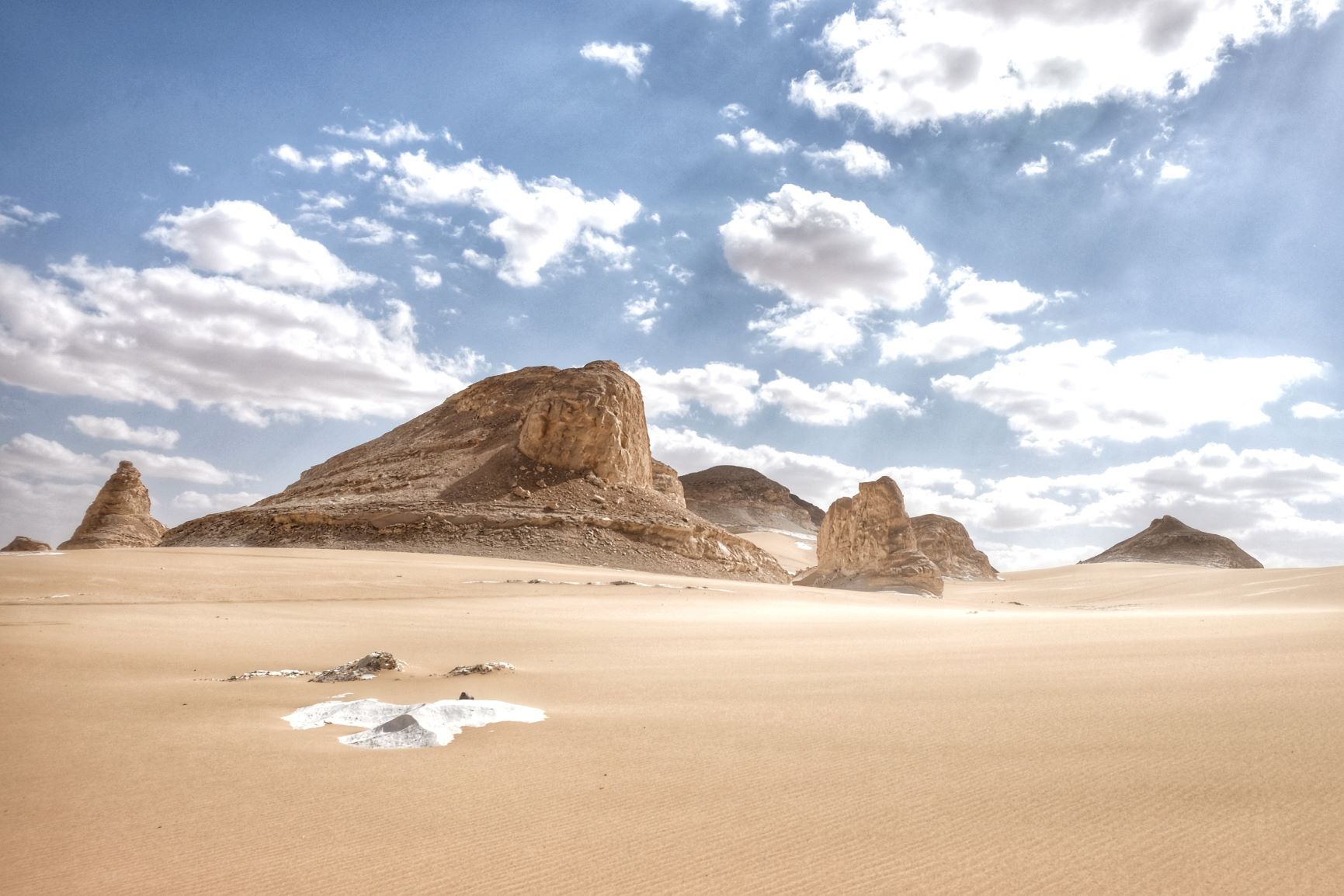





Some guys brought light enduro bikes on a trailer, some just drove the 4×4 cars. For the three days, we just explored the desert and played on the sand dunes.
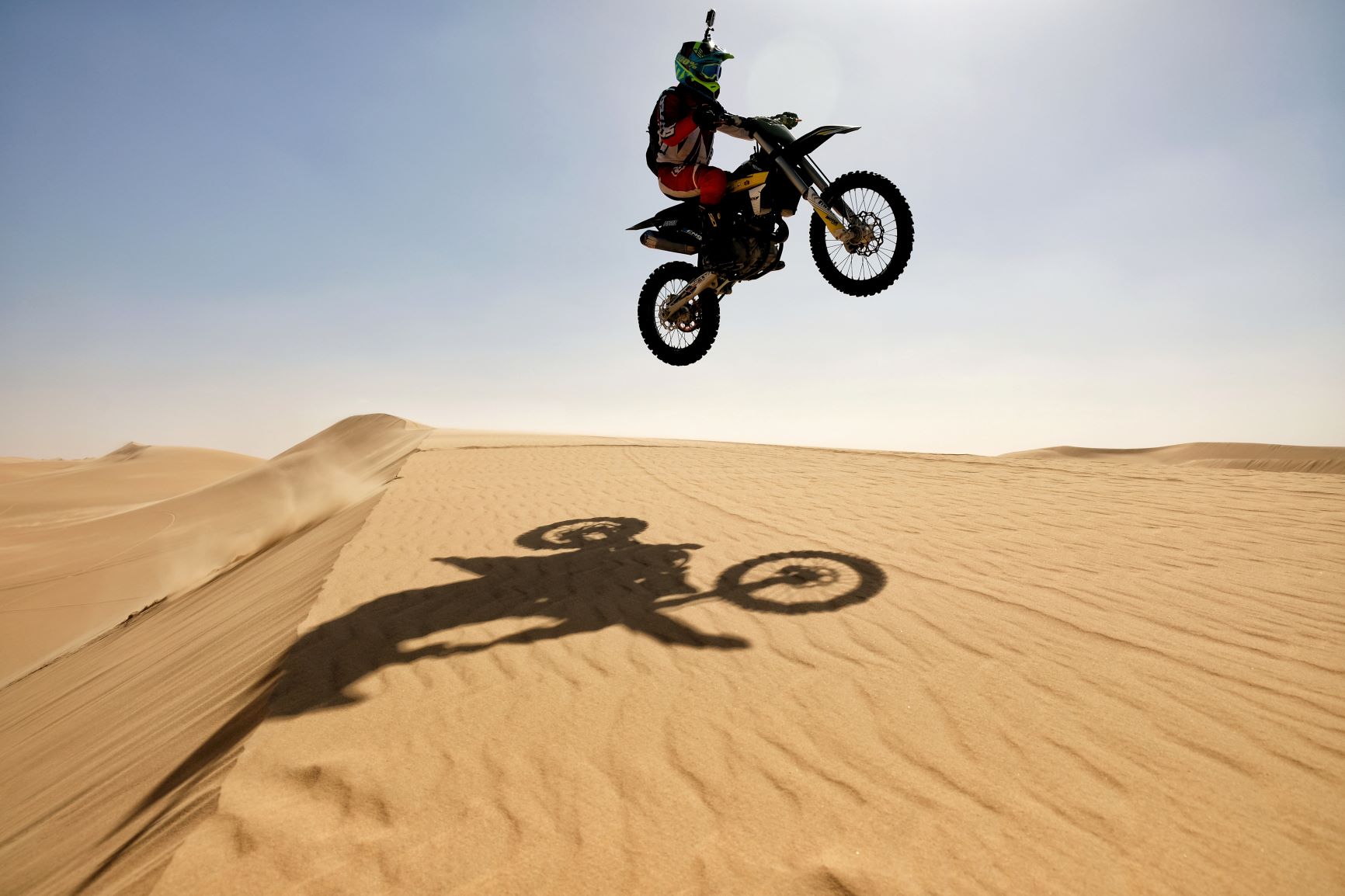
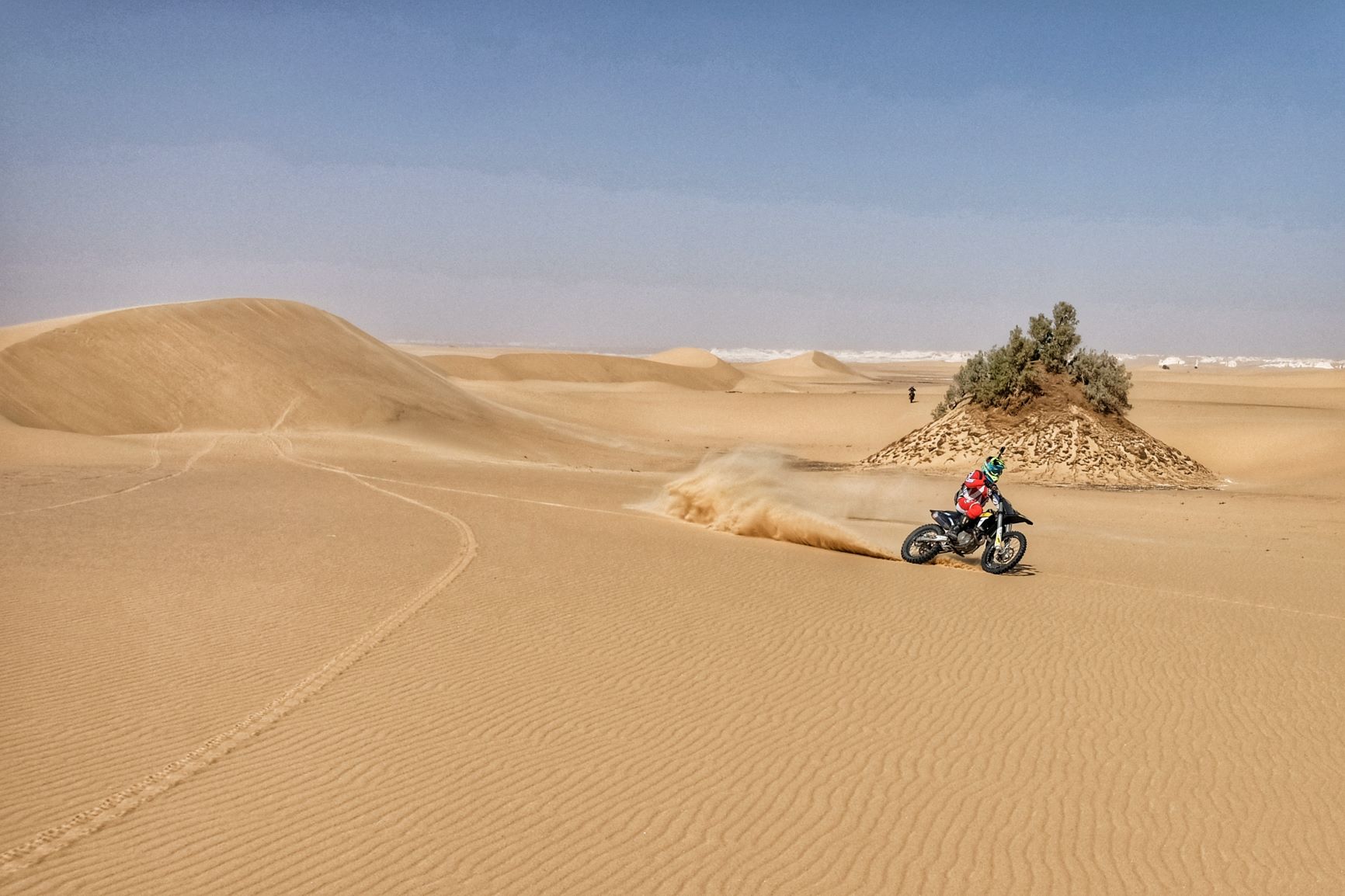
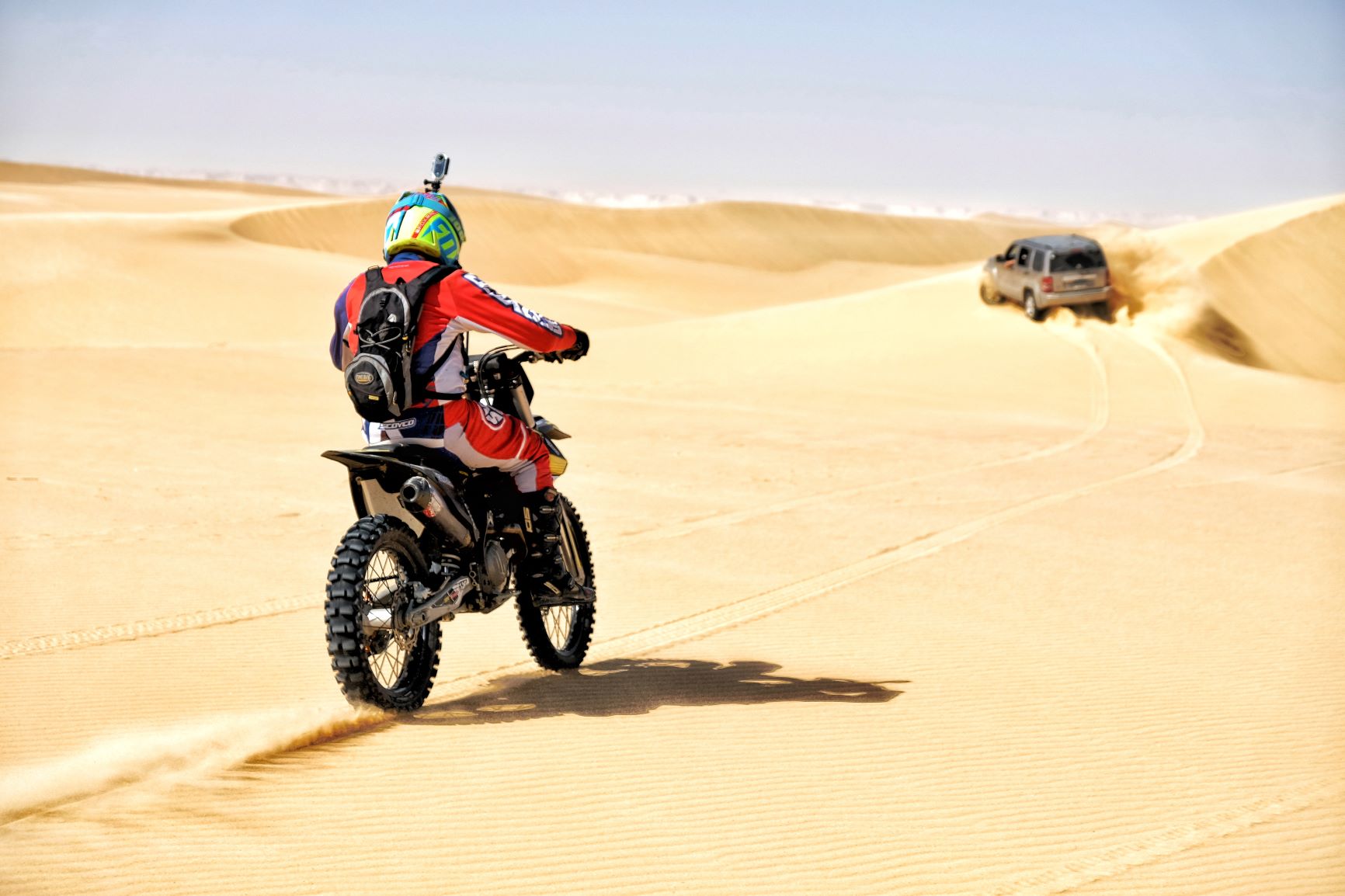
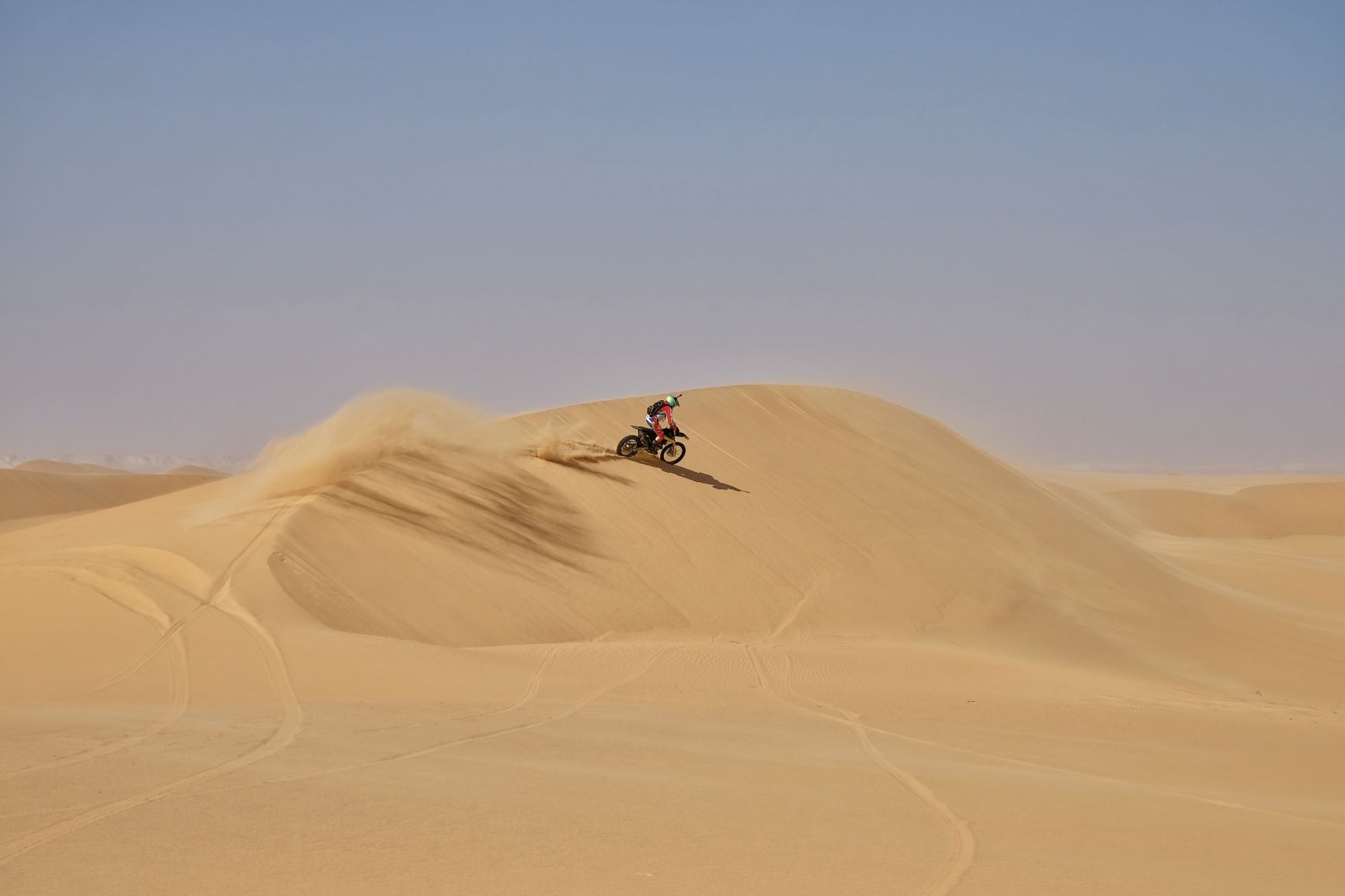
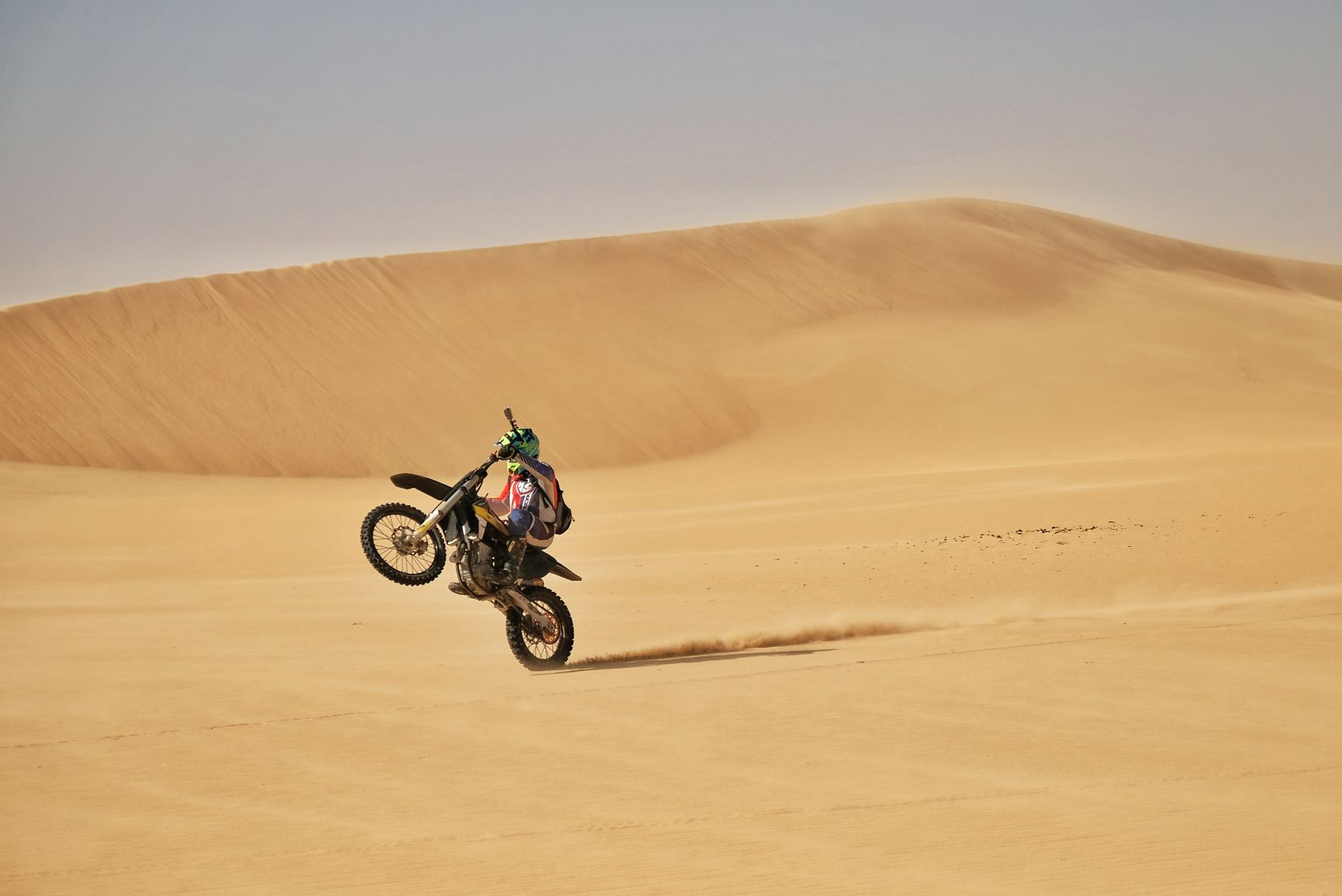
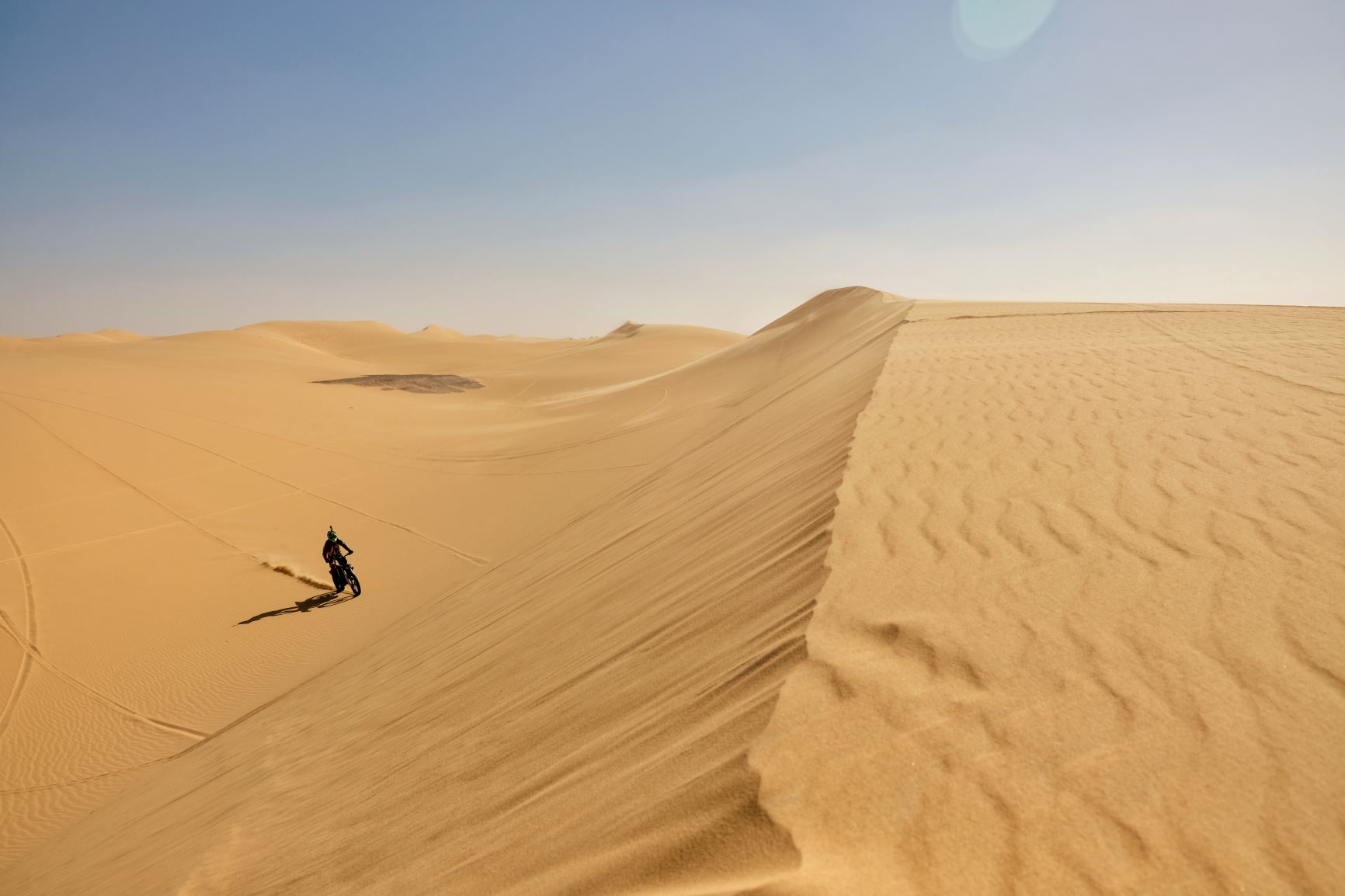


…and damn these boys can ride! Ride like an Egyptian!
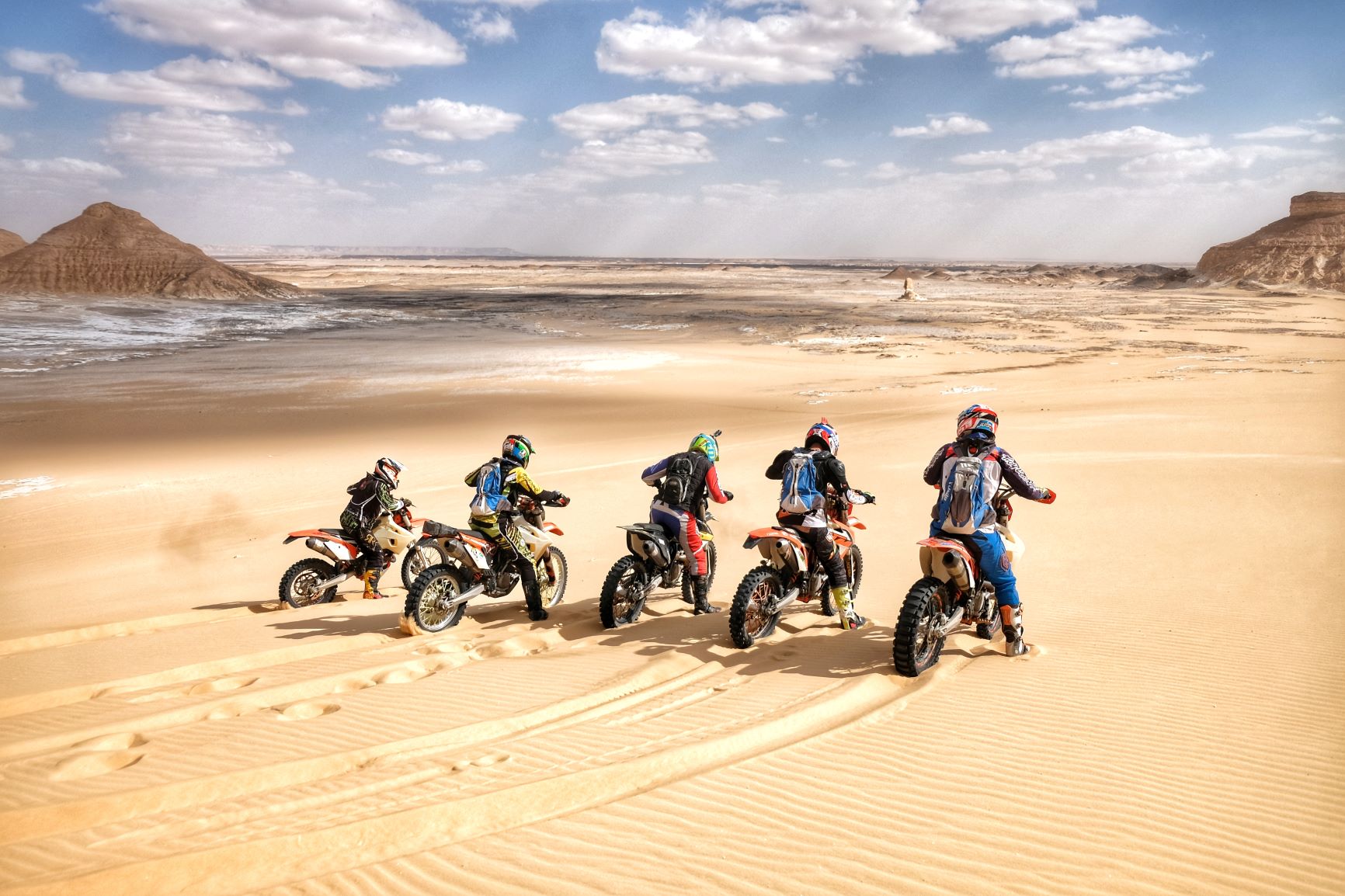

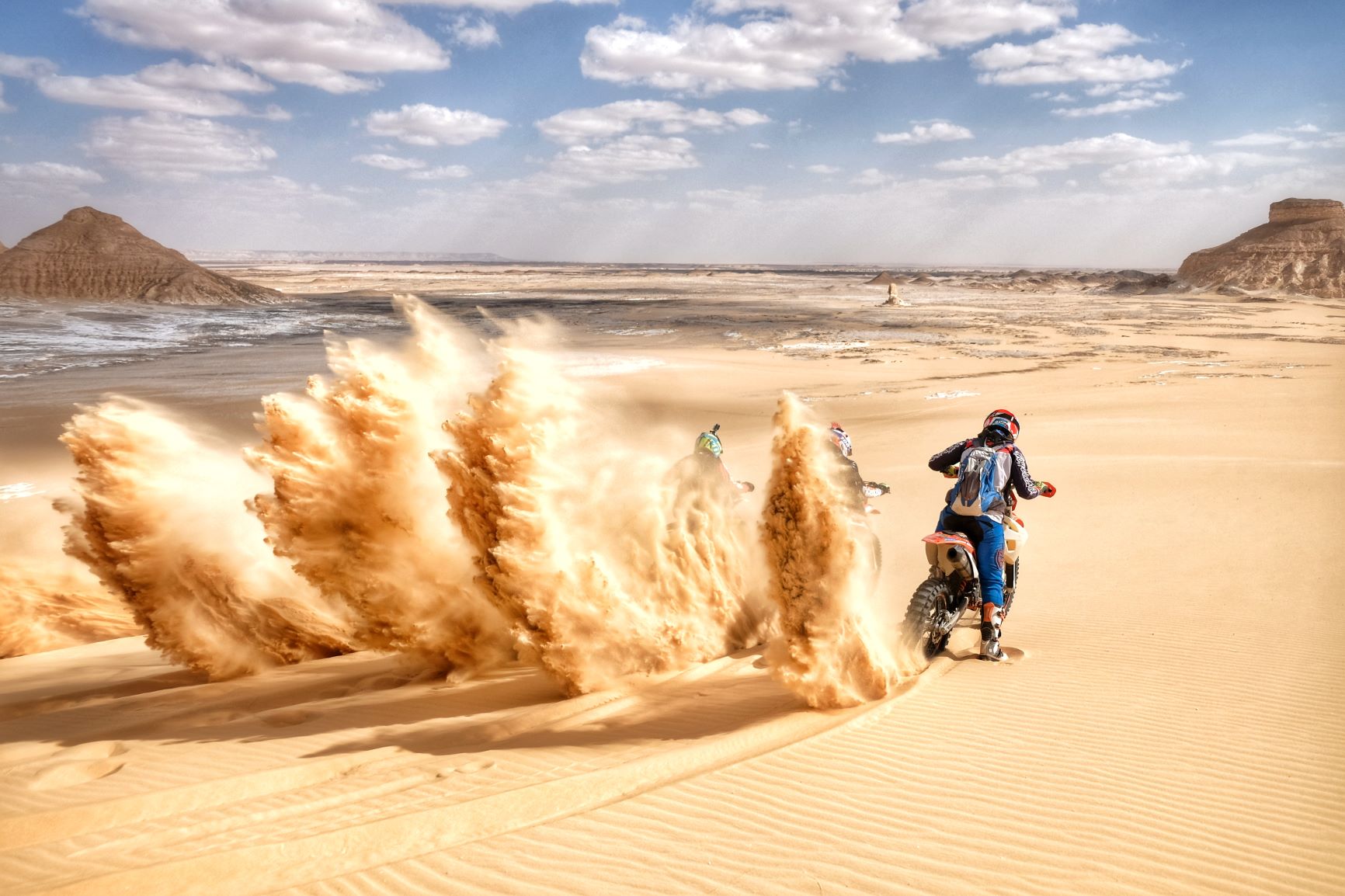
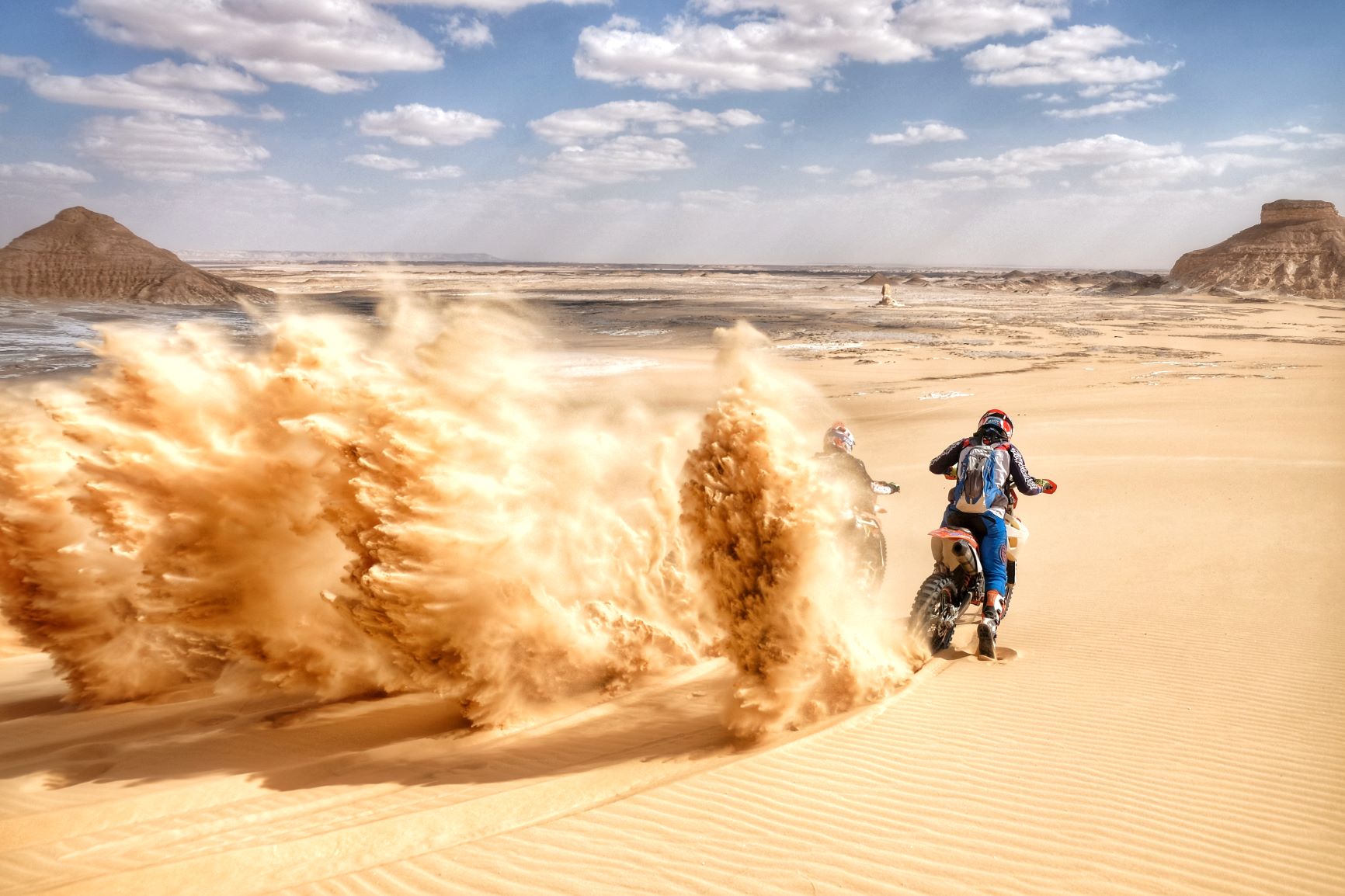
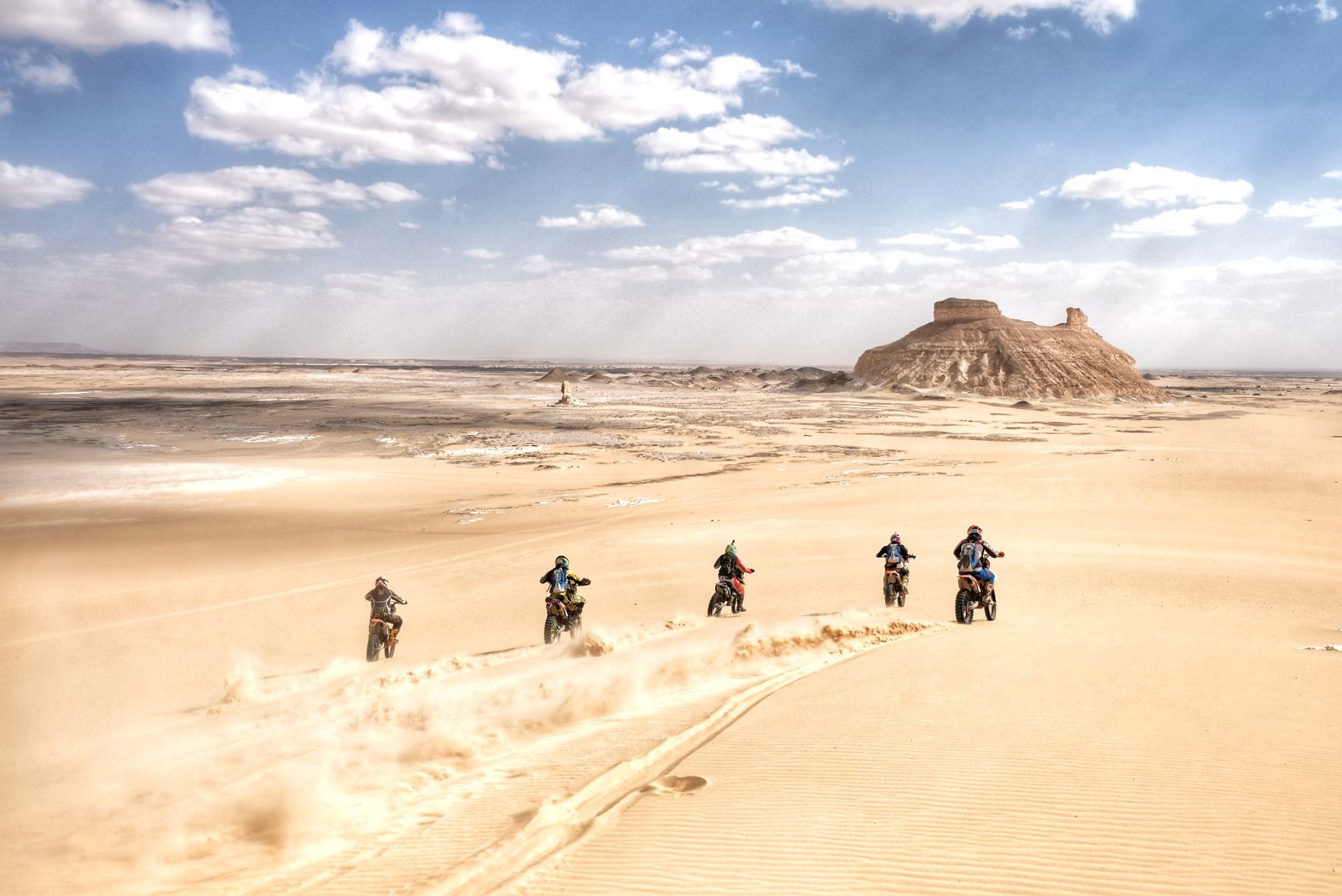
Yara is an excellent driver and I’m a terrible passenger, I only thought we were going to die a few times, but in the end, we survived! Phew!
And surprisingly, except for the moments I thought we were going to die, I really enjoyed just sitting back and being able to grab a camera at any time and look at the scenery.




Local Bedouins cooked all the meals for us at the camp and there was nothing better than chilling at the fire at the end of such an exciting day.



We didn’t have shower facilities so instead we had a dip in some hot springs!


I had a go at riding only once, but I knew I’d be back there with Chillie very soon 🙂
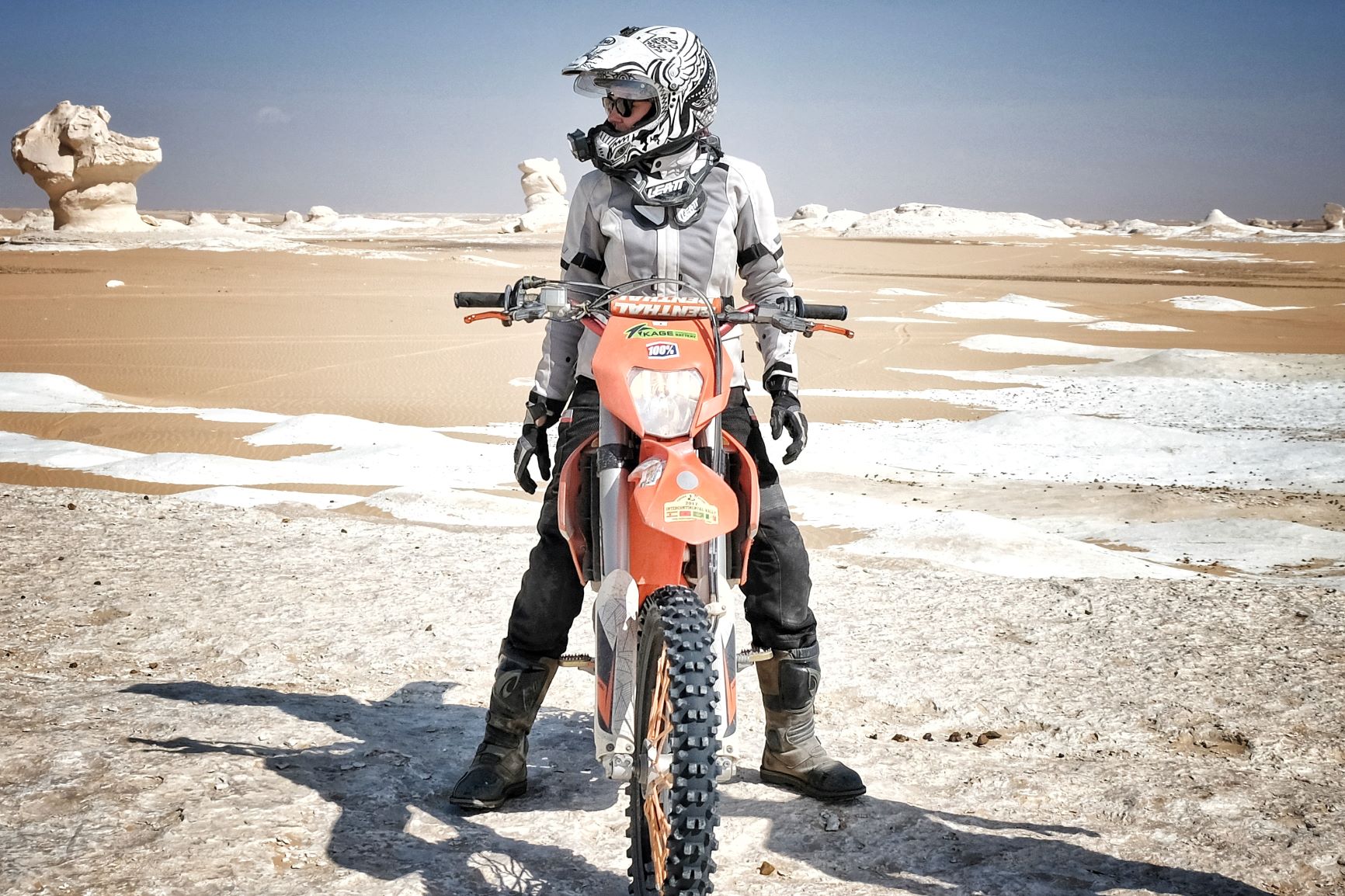 \
\
Getting Ready Again
I had to fly back to Europe for a month so I left Chillie in Cairo. As I returned her new tires were delivered. Finally, the new Bridgestone Adventurecross were out and I was super-exited to test them!
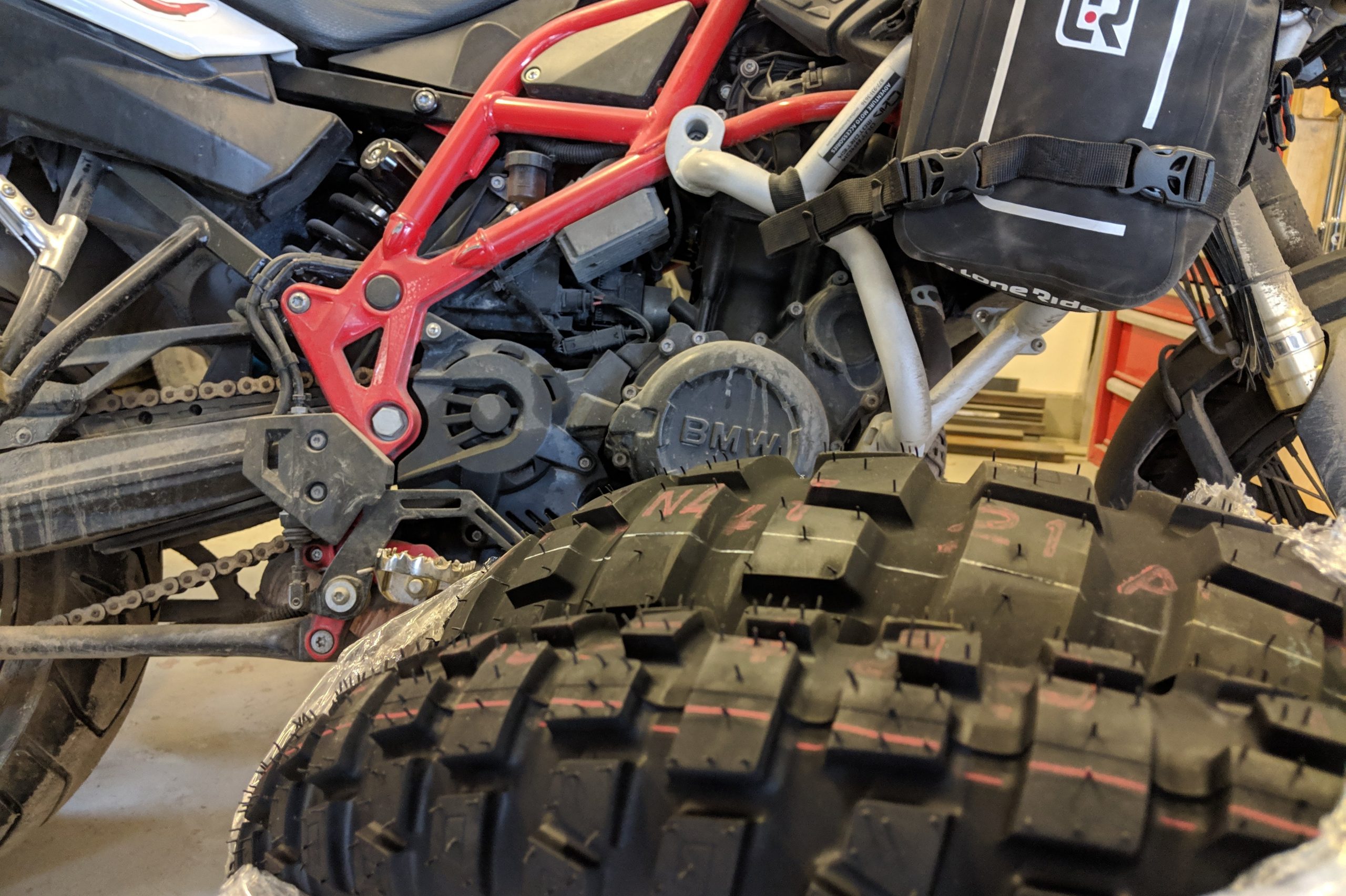
But my biggest stress now was how do I get Chillie out of Egypt as she had been there for 3 months and the carnet was only stamped for 1 month, which means my temporary registration was only valid for 1 month and that means technically my bike was unregistered so I could possibly have big problems at the police checks on my way to Sudan. There are two options in this situation.
Scenario number one – you can get a carnet extension at the customs office. Easily said – not so easily done. My friend Ahmed who works at the Carnet office offered his help. We drove around Cairo for a day to sort out this issue with no luck. When we finally found the Vehicle Customs in the Cargo Village at the airport (where it’s supposed to be done) the officer told us we’d have to go downtown for some piece of paper and come back. That was the moment when my patience with the Egyptian bureaucracy reached its limits. This procedure could on go forever and most likely I would have to pay a fine for overstaying and a fee for the extension of registration and Carnet. So, in my opinion, it’s just a waste of time and money.
Scenario number two – report to the police station that your registration licence have been lost or stolen. This advice came from my local friends who had helped a lot of overlanders and it worked for me very well. The next day I headed to the police station to report my lost documents. I attempted to do this on my own, but unfortunately, after an hour of keeping me at the police station, the officers told me I needed to have a local with me as a witness. So Ahmed had to come to the rescue again. And finally, the mission was complete – I got my report which would help me get through the police checks. Thank you so much Ahmed, for all your assistance!
Western Desert
And it was finally time to start moving again! I had about 1500 km from Cairo to the Sudanese border and so much to see! I’d chosen to take the road through the Western Desert because I fell in love with the Egyptian deserts way more the coastline.
Omar from Alexandria joined me for a few days of riding on the way down South.



Omar knows Egypt like the back of his hand… so all I had to do was follow him, but under these conditions, I might as well have been blindfolded. We got caught in a sand storm but there was something mysterious about it. I just felt like I’m in The Doors song…
Riders on the storm
Into this house we’re born
Into this world we’re thrown
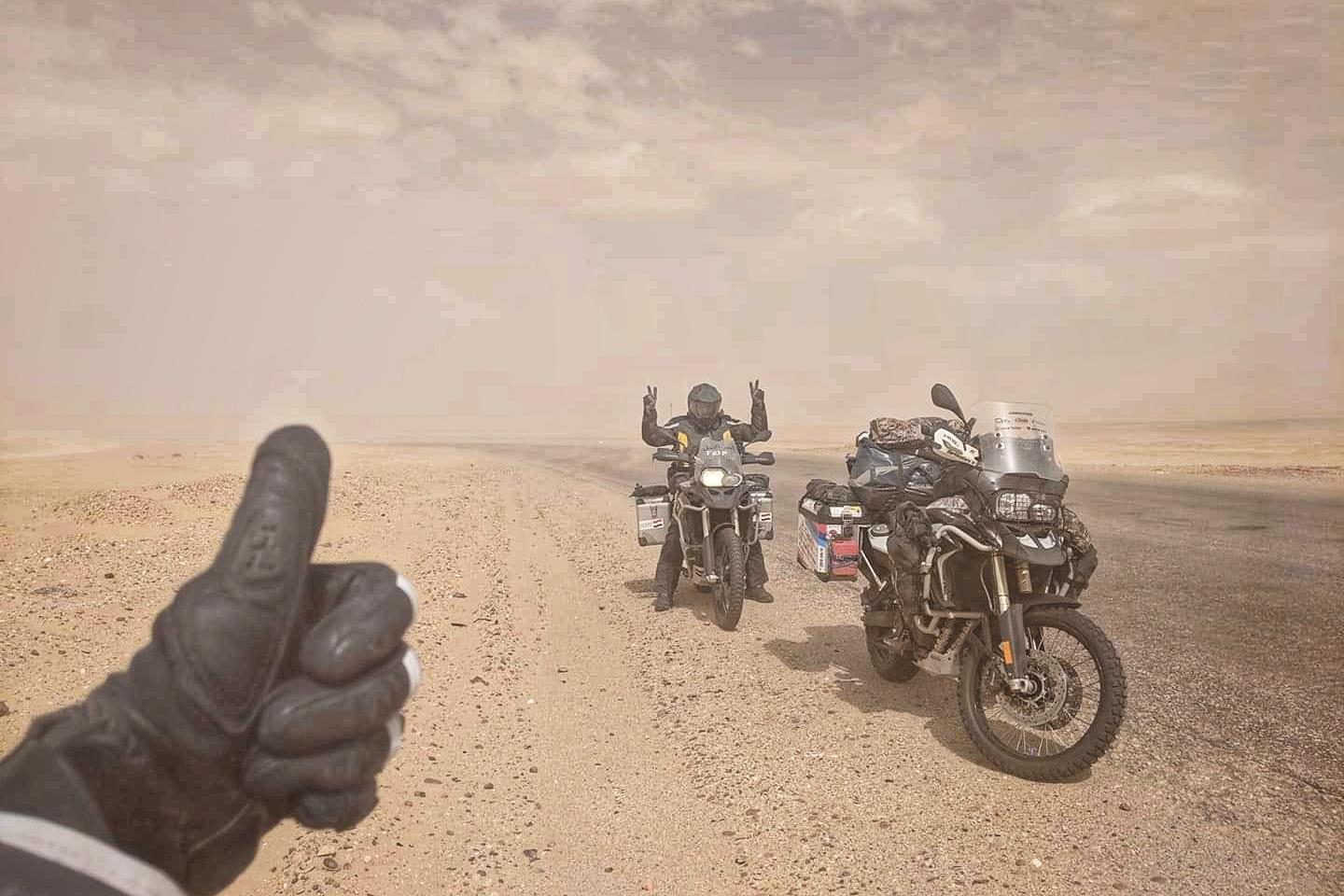


And finally, we reached the Bahareya Oasis where we stayed at the International Hot Spring Hotel. Omar knows some locals in town so we socialised a bit with the guys for a couple of days.
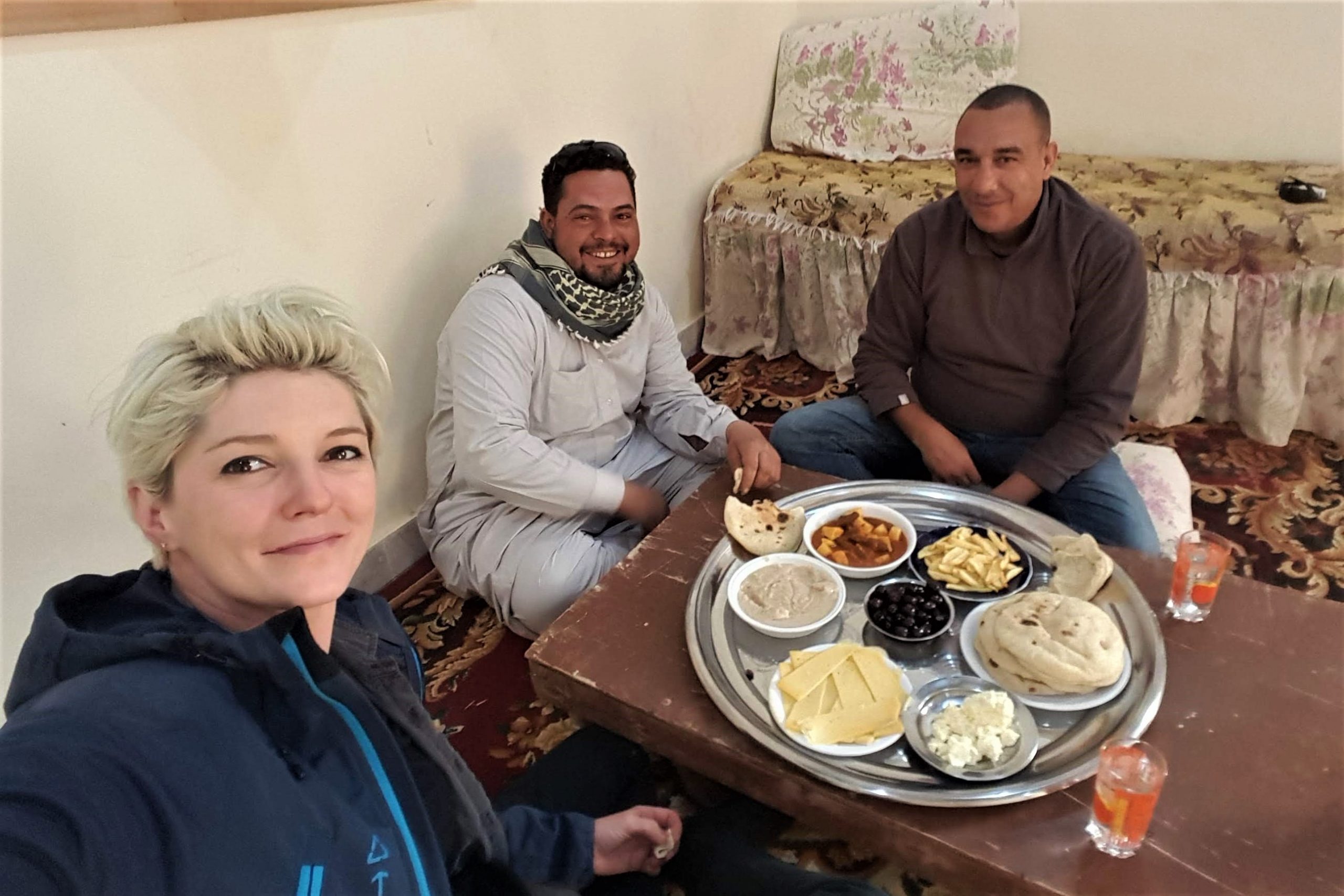
And when the weather finally cleared up a little we headed for the White Desert. Technically camping in the desert is not allowed unless you have special permission. And it’s a bit difficult to get such permits if you’re a tourist on your own. Neither last time when I went to the desert with Yara and her friends, nor this time with Omar did I have such permits, but it does make it easier when your Egyptian friends are doing all the talking at the checkpoints. We had no issues on the way to the white desert coming from the North, but I had to explain myself a lot while travelling further South – I’ll explain that later on.
Although it was super windy we’d decided to stay and camp in the White Desert. I was so happy to be back there again. and cherish this breathtaking scenery…



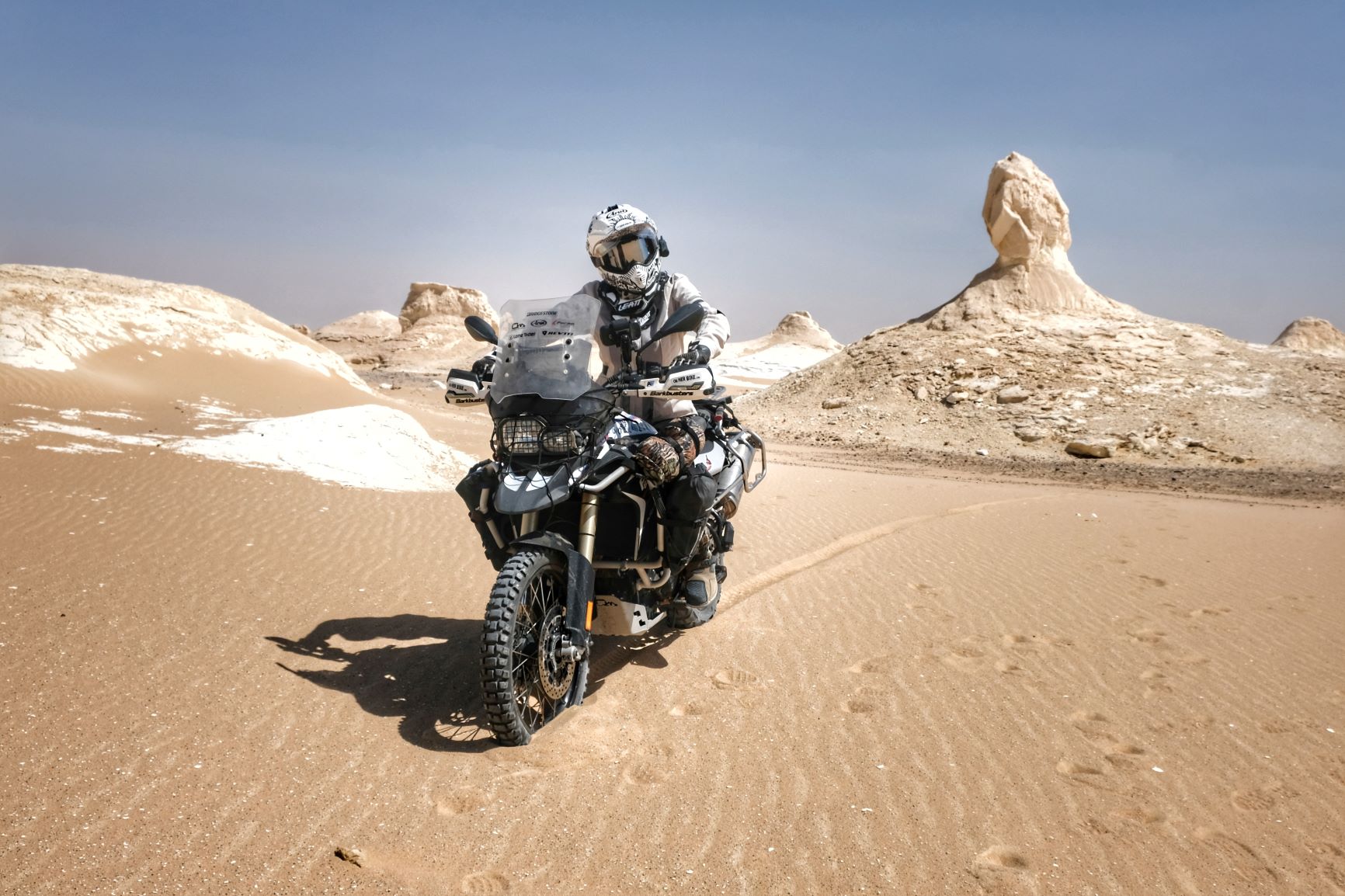

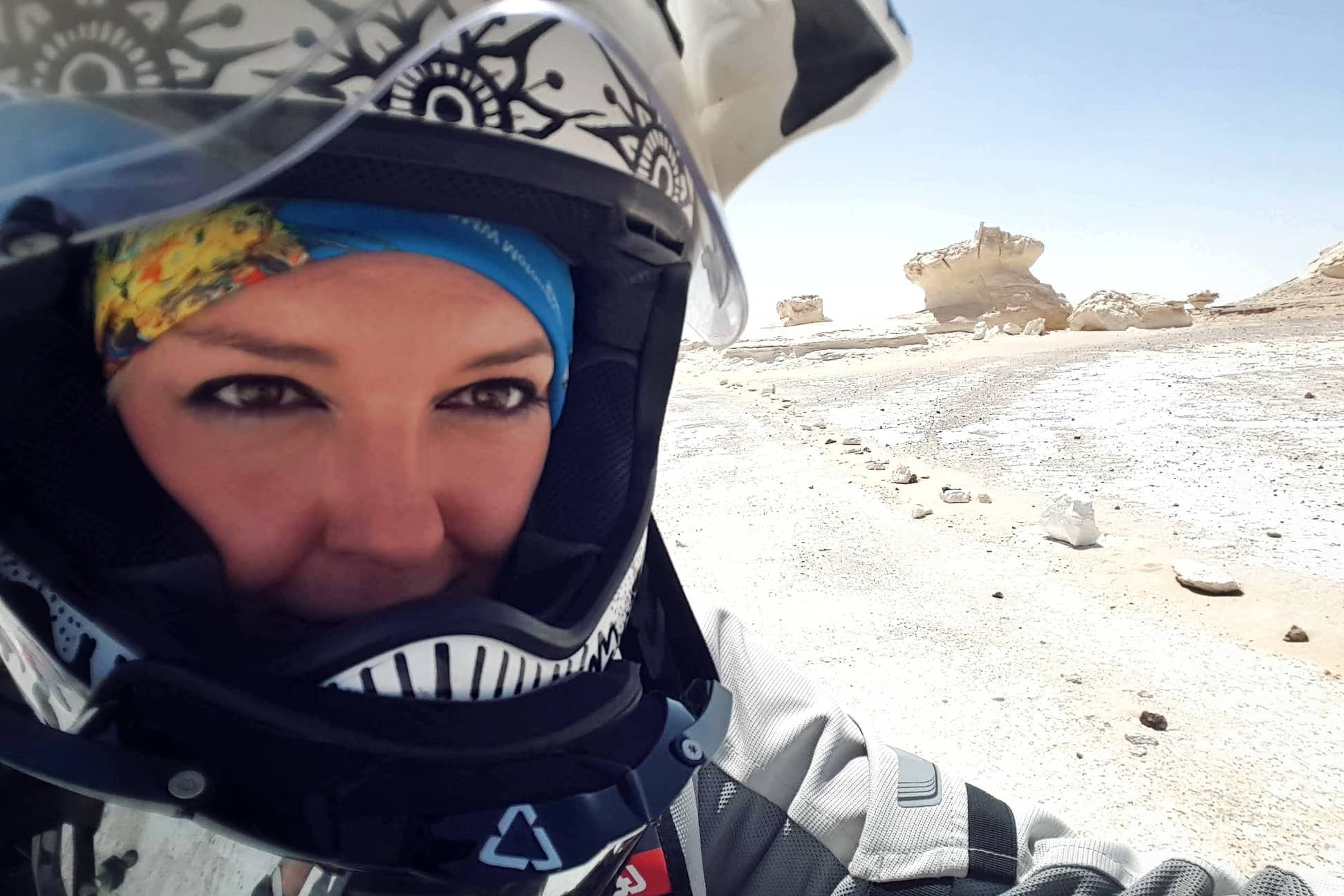
We set up camp close to the trail so every time we saw a car coming we would ask them for some wood. And it worked quite well. Everyone was happy to share their firewood with us. Omar cooked a delicious dinner and we stared at the stars looking for constellations.
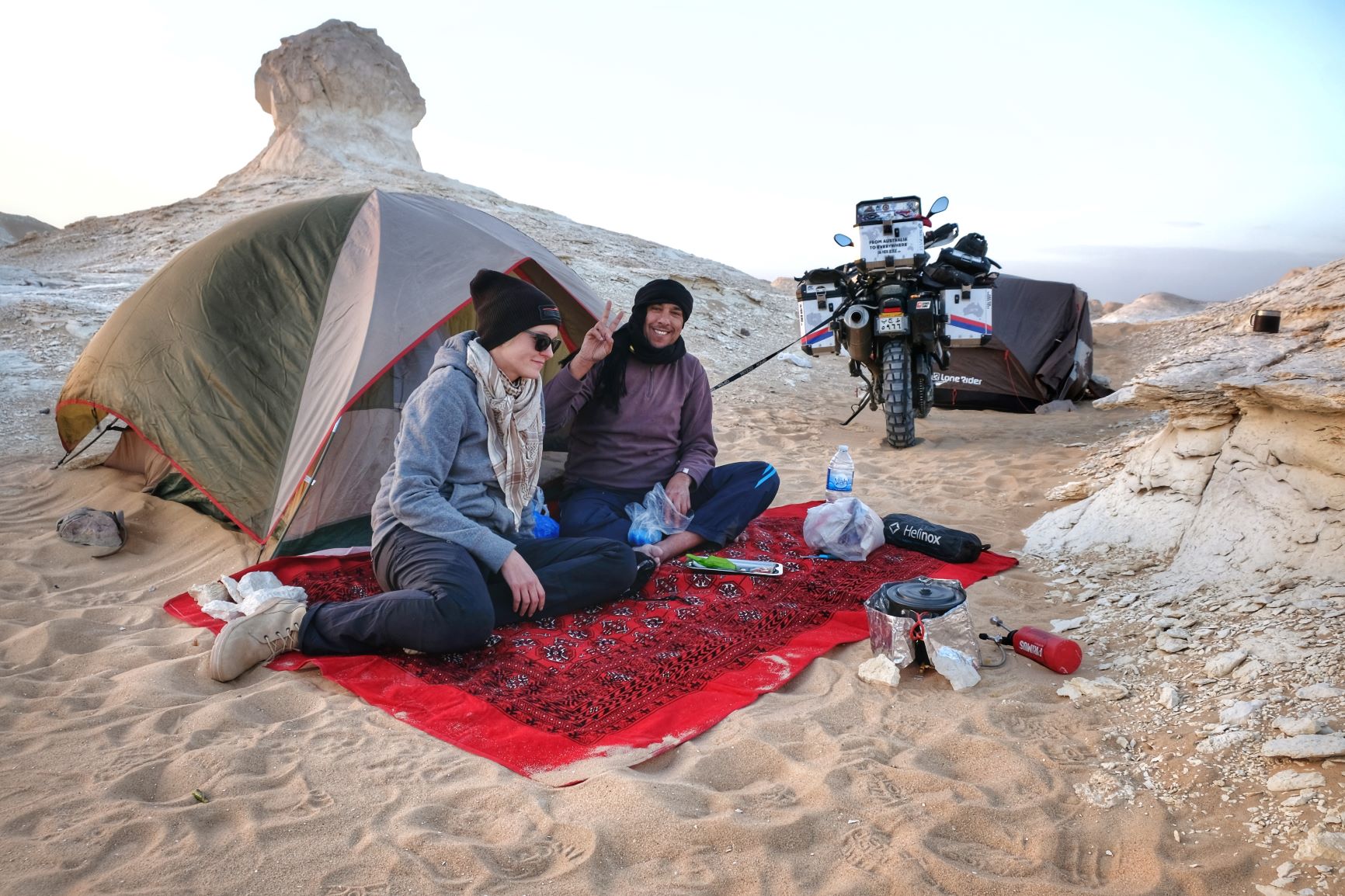
In the morning we managed a quick tidy up… electric toothbrushes are sooooo overrated.

The next day we wanted to get to the El Dakhla Oasis but we didn’t succeed. We were stopped at the El Farafra Oasis checkpoint. The Police asked us for our permits and I was advised not to continue along the Desert Way if I wasn’t registered with the Tourist Police. On our way to the Tourist Police, we stopped at the petrol station to fill up and we were invited into the office for a cup of coffee. Turns out it was intelligence officers who wanted to know how we got there and why we were travelling through the desert without permits. Omar explained our situation the best he could. Everyone was super nice so it didn’t feel like we were in trouble. I was advised that if I continue South through the Western Desert I may have the same problems later on. Basically, the authorities don’t want tourists to wander through the desert in case something happens. So their advice was to head East from there to the Nile River road which is the main and preferable route for tourists.
We already knew we were not going to get out of this town that day so I said goodbye to Omar who had to head back home. I was advised by a Tourist Police officer to stay there for the night at the Rahala Safari Hotel. There were no spare rooms for the night but Ahmed the owner allowed me to sleep on the floor in a spare chat for $9.
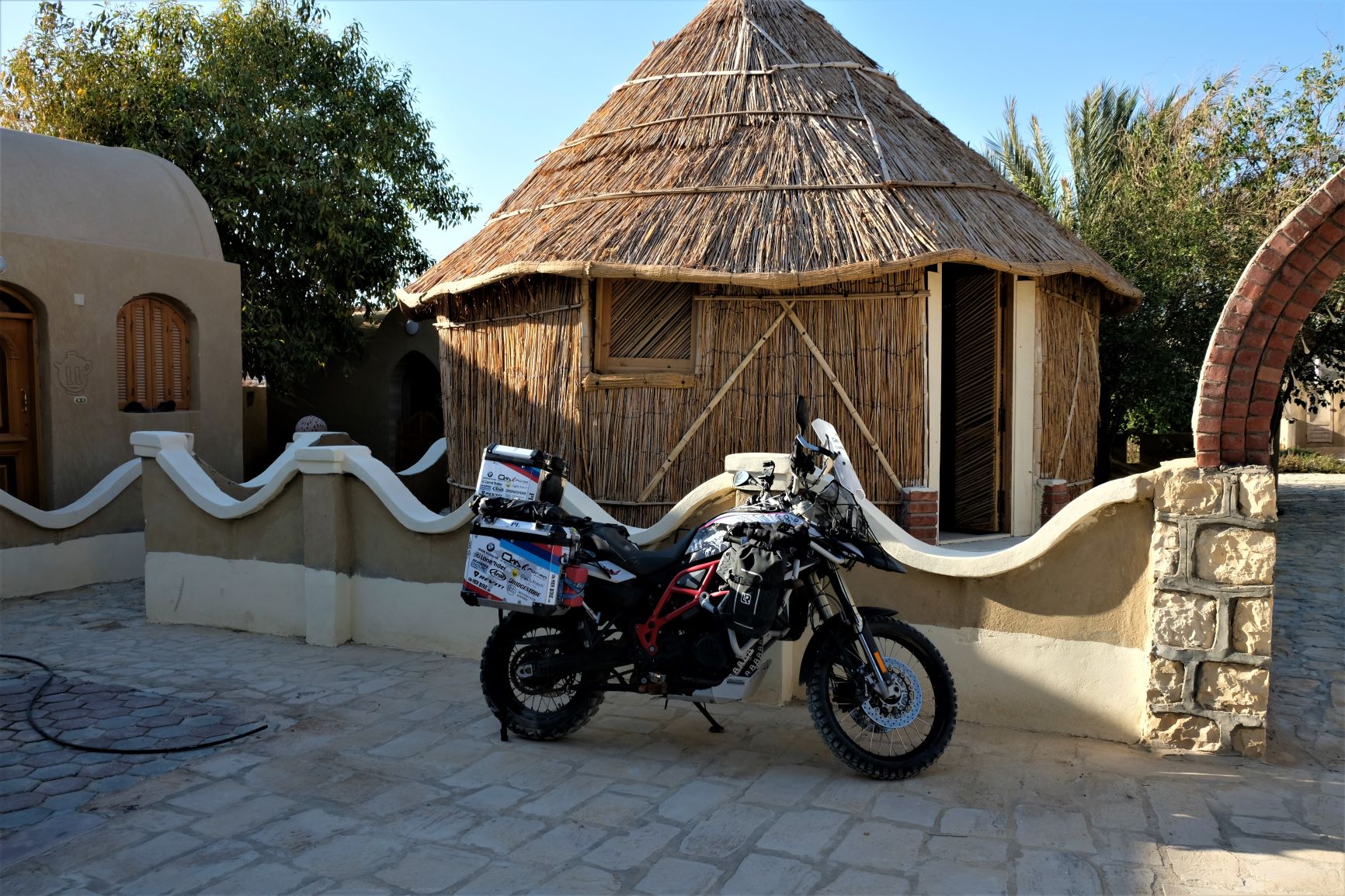
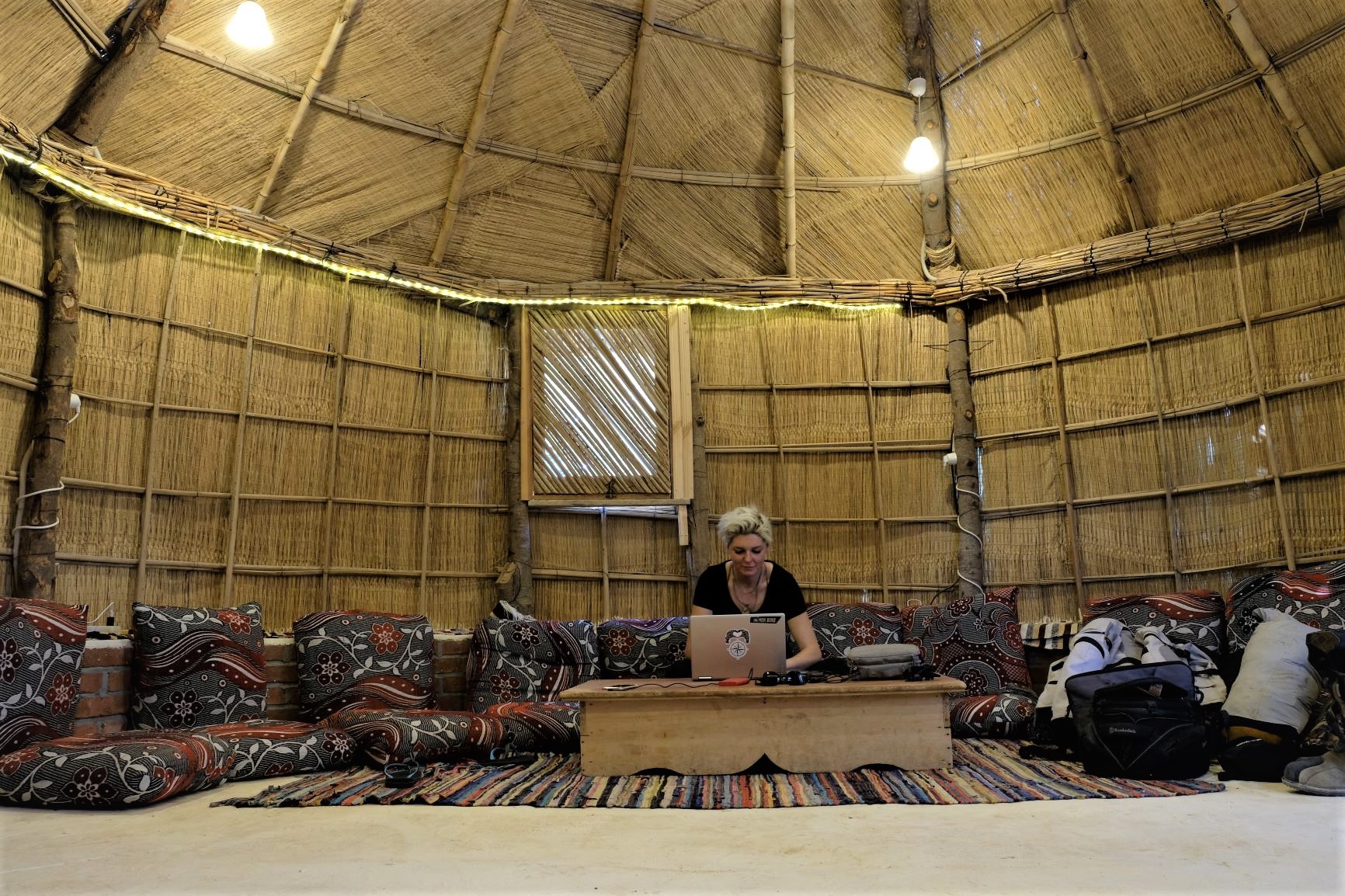
The next morning I went back to the Tourist Police and asked if it was ok if I continue along the Desert Way to El Qasr Oasis, they said: “No problem, you can go”. So what the hell was all the commotion about the day before. And that’s how it is in Egypt. There are lots of rules and ways around them and it all depends on the attitude of the officer you’re dealing with.
I continued South and expected to have more complications at the checkpoint, but it was all smooth riding till the Sudanese border. I crossed a lot of police checkpoints, but officers were only checking my passport and taking selfies. Also, I didn’t get asked for registration papers so I didn’t have to use the lost documents police report I got in Cairo.
There were a few tourist attractions I got to see along the way.
The Old Village of El Qasr said to be the oldest continuously inhabited and best-preserved settlement of its type in Dakhla. 700 people still live in the town that not so long ago was home to several thousand. A very interesting site.




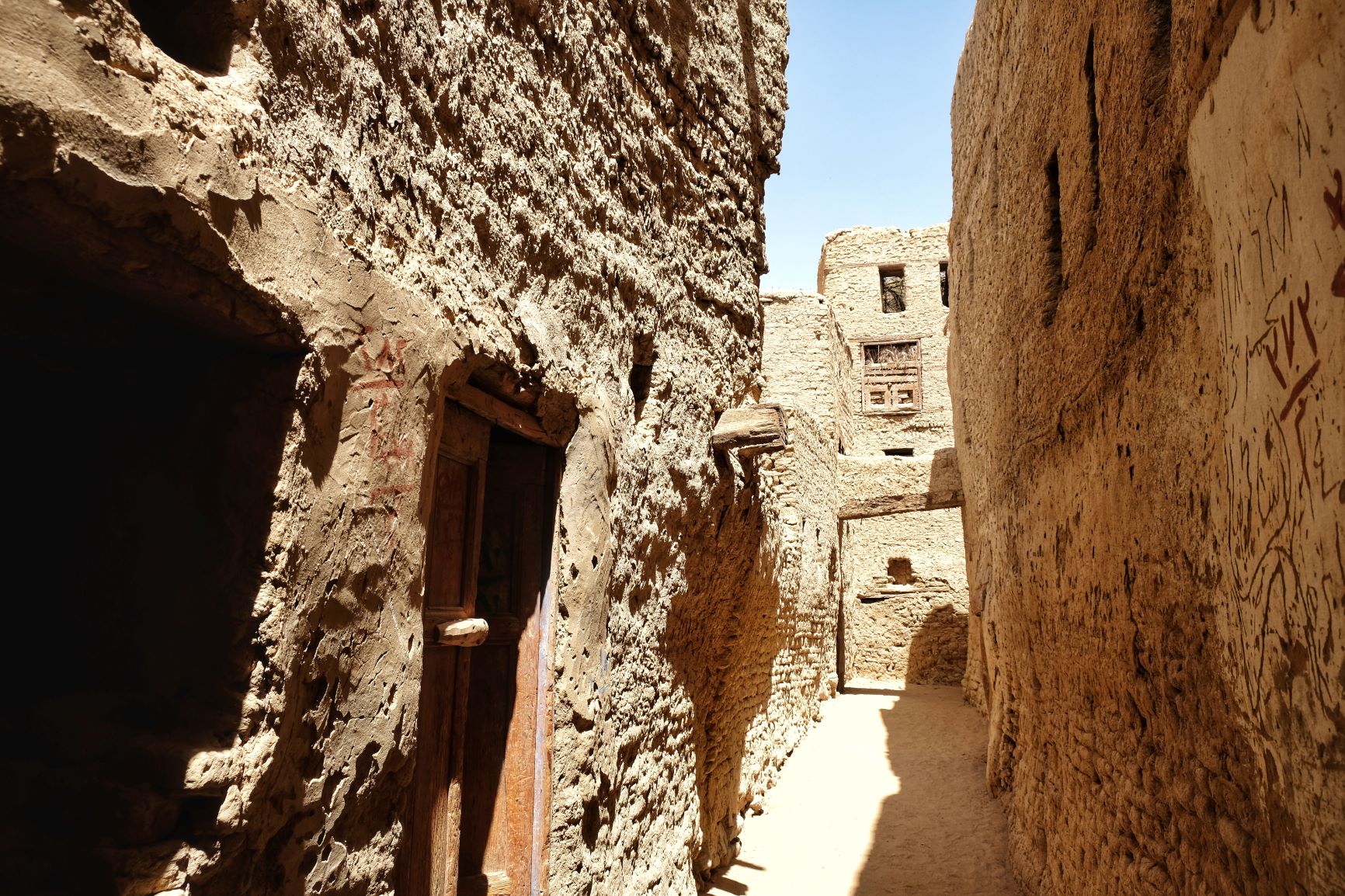
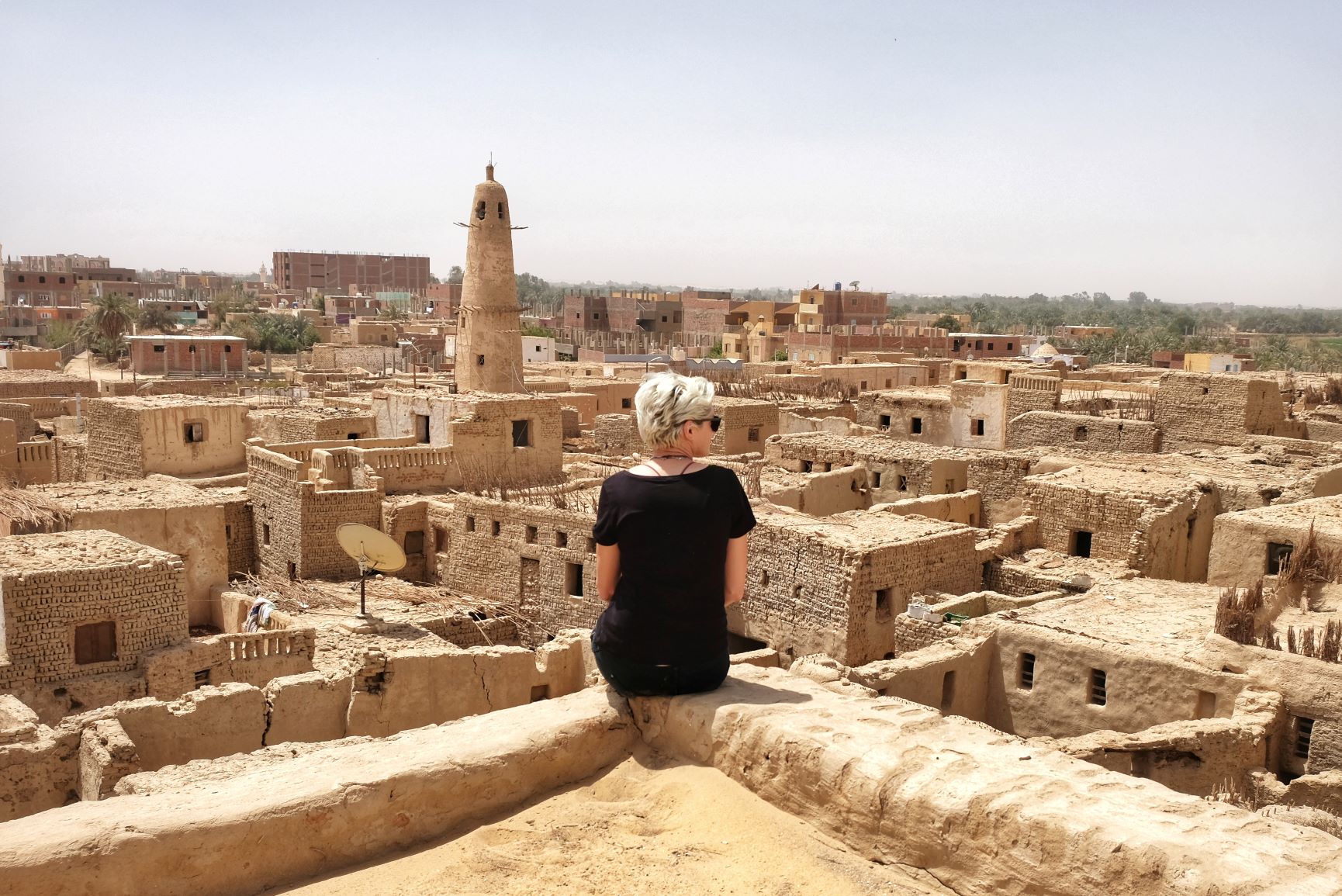
I stayed for 2 nights on the outskirts of town in the Beir Bebel Tourist Camp. Their chalets were quite affordable at $15/night. They had a nice green garden where you could chill in the shade of trees – you appreciate that out in the desert.

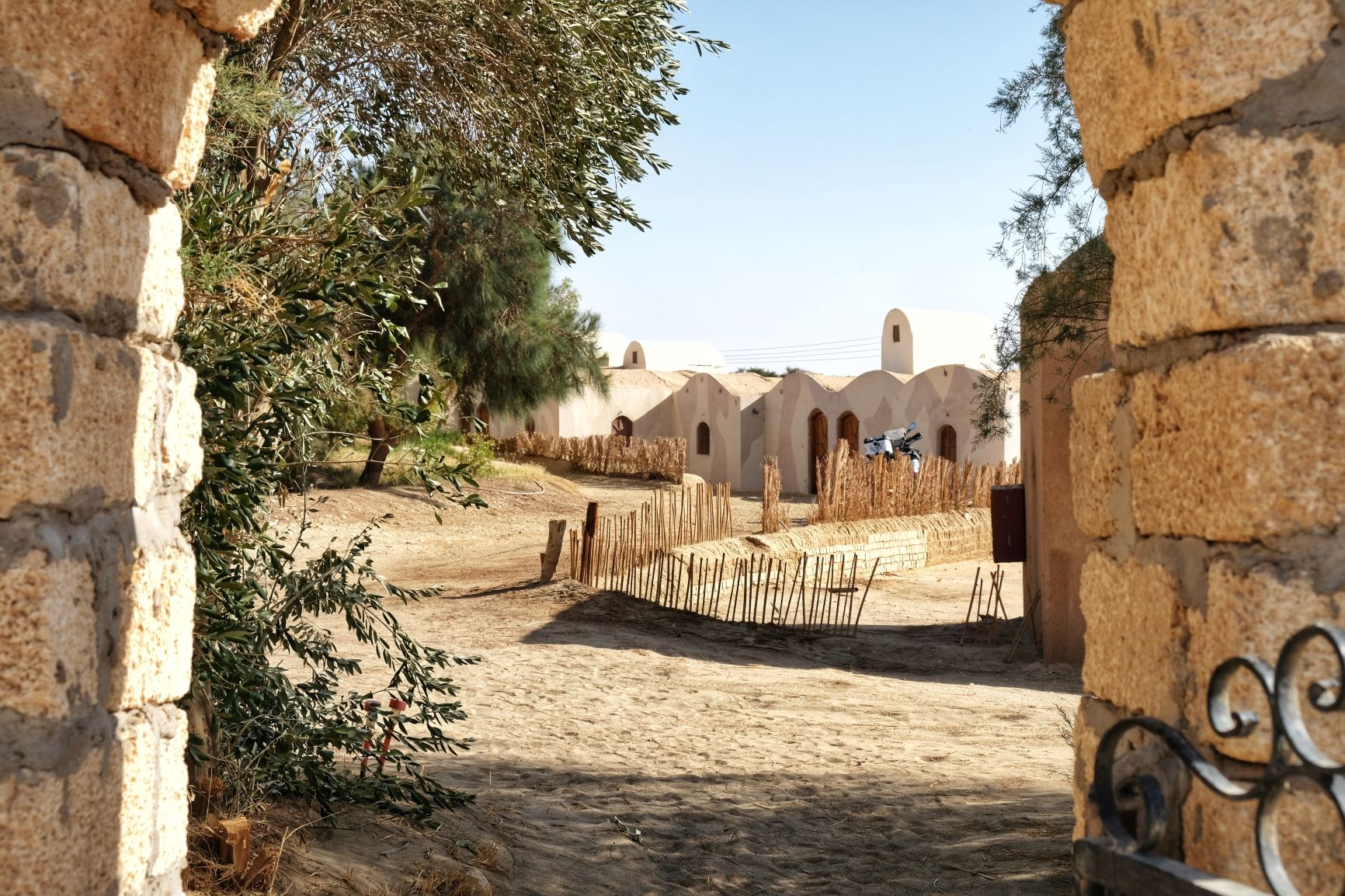

And the valley nearby is just amazing…

Sleep tight sun, I’ll see you tomorrow.

In Luxor, there’s lots of ancient stuff to see, but by that stage, I was tired of the crowds and sightseeing. I joined a half-day tour from the hostel to the main attractions Valley of the Kings. Dair El Bahari and Temple of Hatshepsut. But there’s so much more to see in Luxor and you really need to allow yourself 3 – 4 days to see it all.


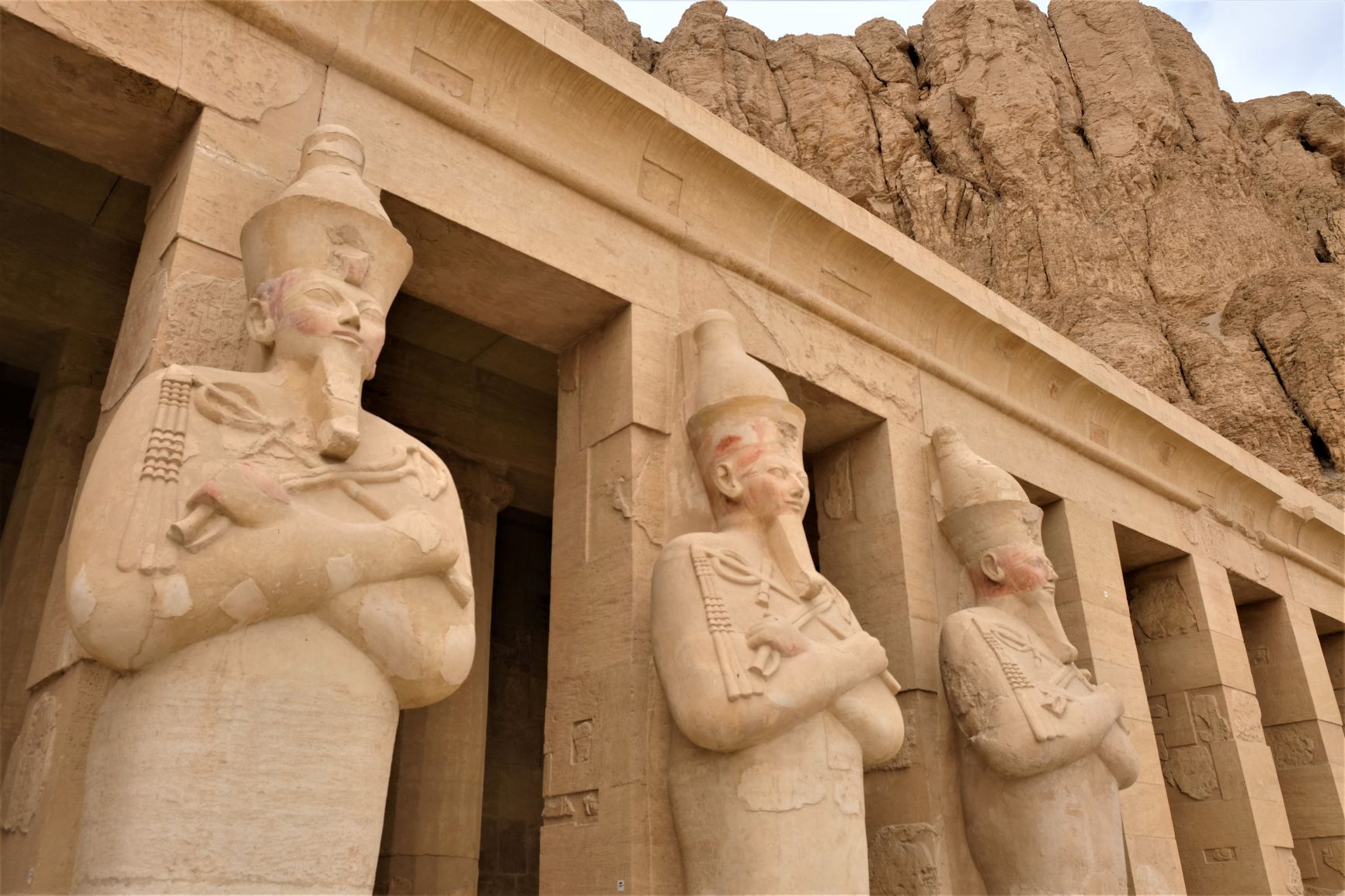

In Aswan… a felucca cruise on the River Nile is a must! You can do multi-day cruises on these little sailboats – you just chill and sleep on their comfy mattresses. I only spent a few hours on this boat with Captain Safi. I wish I’d had more time than that!






Getting out of Egypt
Abu Simbel is the closet town to the Sudanese border crossing. When I arrived there my mind was already set for getting out of Egypt. I couldn’t bear the thought of another tourist attraction and dealing with locals who take advantage of tourists at every opportunity. There are famous temples to see there, which I missed out on, I know, I regret it. I wish I had the extra energy to see them.
I checked myself into the Nobaleeh Ramsis, one of the worst hotels I’ve stayed at. The hotel was under renovation, workers were sanding the floors so there was dust everywhere. The room was filthy, sheets dirty and smelly and it was overpriced. That was the straw that broke the camel’s back. I needed to get out of there ASAP. Two months in Egypt turned out to be a little too overwhelming for me.
After all the experiences during my entry into Egypt, I just wanted to save myself the hassle and so arranged a fixer to help me with the paperwork.
I met my fixer Hamada at 7 am in the hotel and he escorted me to the ferry. There are two types of ferries to cross Lake Nubia. The ferry ride takes 1 hour. For me this was a very social moment because all the truck drivers were very interested in Chillie and wanted to take pictures.



From the ferry, there was still 30 km to the border. My fixer got a lift with one of the trucks so I met him at the border.

This time the procedure on the Egyptian side took only 3 hours and for the majority of that time, I sat in the shade while my fixer was running around doing all the paperwork. A much less stressful experience this time.
And these are the fees I had to pay at the border:
EPG£ 1180 ($70) fine for the expired carnet and registration
EPG£ 600 ($37) border check
$50 fixer fee
And finally, I was out of Egypt!
In Numbers:
Duration: 14th January 2019- 9th April 2019
Total km’s: 2822km
The “Are We There Yet” World Tour is about more than just me seeing the world on a motorcycle. Throughout my journey I’m raising money for a young disabled child in Poland named Franek. Franek was diagnosed with cerebral palsy (weakness of the entire right side of the body) and he will require constant rehabilitation for the rest of his life. All the money raised will go directly to helping Franek and his family lead as normal a life as possible so please donate generously:
www.gogetfunding.com/arewethereyet
Check out my videos from Egypt!


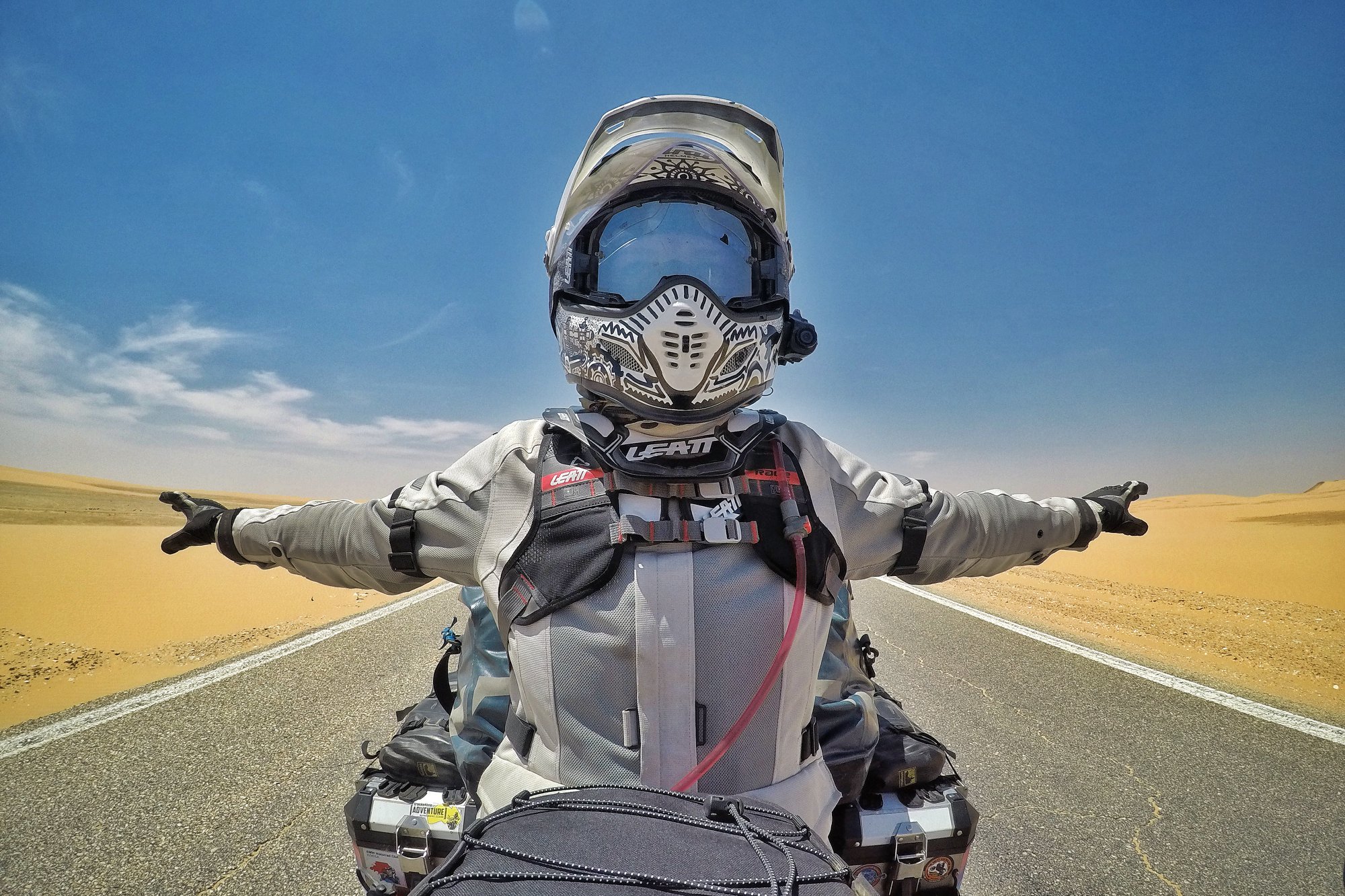

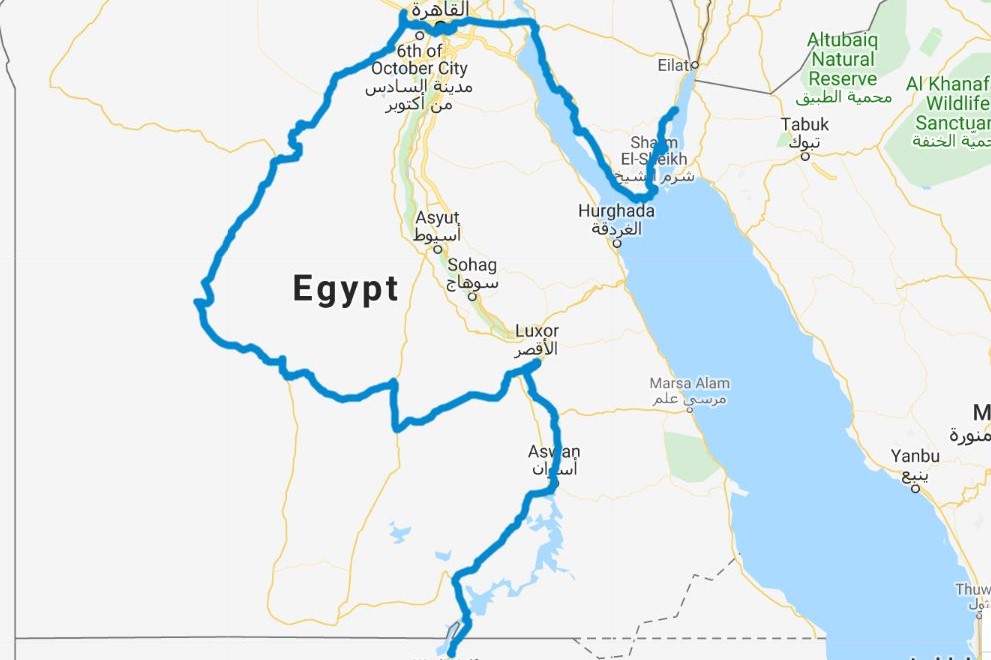

A very interesting journey indeed. I like that you include your costs at the border.
Ride safe.
Great journeys! Thank you for sharing. Egypt is my favorite bc of very ancient temples. I used to visit it in past lifes also (during Alexander the greatest times).
WoW you have made some super fine quality photos here, Thanks I Enjoyed see them.
Wow it’s very inspiring
I am Egyptian and I visited all this places before but I need to try it again on my bike
مغامرات رائعة، اتمنى لك الصحة والسلامة
keep riding
I loved this post! I went to Egypt about 20 years ago and it is still one of the best trips I e ever taken ! U got to see much more of the locals which is cool. A lot of the pictures look very familiar of places I went to also. I have to agree at the end it gets a little tiring doing all the touristy stuff. Even our guides( who were the best!) would jokingly hold up a sign that said ABT- another beautiful temple! I pushed through though because I knew chances ere is never get back over there. Your blogs are awesome – I love all the details!!
Hey,
I am fan of you blog, it helps me to improve my study. Thanks for presenting such nice and great informative article named Egypt.
Cheers
Great write up, thank you or the insight.
Just wondering, is it worth going he Jeddah to Port Sudan route by ferry, acknowledging the additional distance of going up to Cairo and then back down the east coast of Africa to get to South Africa – assuming that’s the final destination on the continent
Wow, what an amazing place, Egypt is full of mysteries.
another great blog – keep them coming
What an amazing read… and quite an inspiration too! I loved the details and costs you included and the bits about the people you met along the way (particularly the ones who helped). It is unfortunate that the bureaucracy and tourist scammers were a deciding factor in cutting your trip short. I hope that at some point someone in the powers-that-be finally understands that this is killing repeat tourism to Egypt and they fix the system and also crack down on scammers at tourist sites.
Anyway, the positive side is that even as Egyptians many of us miss out on many of the places you’ve seen, so perhaps with this we can start to generate more interest in domestic tourism and maybe even at some point, this awareness improves how motorcycle tourism is perceived in Egypt.
Happy rides.
I’m glad I found your site! I’m heading to Egypt for 16 days in Oct ’25 and want to ride. Appears there are not that many organized motorcycle tours. I’m wondering if anyone out there wants to do a little tour with me